PinotFile: 8.11 February 15, 2010
|
Green Valley Pinot Noir: The Secret is a Three Letter WordThere are thirteen appellations in Sonoma County, but it is the western maritime-influenced appellations that are most suited to growing Pinot Noir. These include the Russian River Valley, one of its subsets, Green Valley, and the Sonoma Coast. Green Valley is located in the southwestern corner of the Russian River Valley and is one of the smallest appellations in Sonoma County. It encompasses 19,000 acres, with 1,200 acres planted to vineyards. The towns of Forestville, Graton and Sebastopol form the eastern border, and the tiny town of Occidental defines the western boundary. The appellation is referred to as Sonoma County Green Valley to avoid confusion with another California appellation with a similar name, Solano County Green Valley.
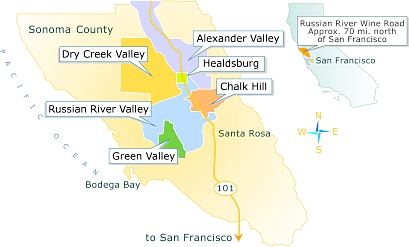 The Russian River Valley viticultural area, except its southern tip in Green Valley, lies within the Northern Sonoma viticultural area. The Northern Sonoma viticultural area, in turn, lies largely within the Sonoma Coast viticultural area. Both the Northern Sonoma and Sonoma Coast viticultural areas are both entirely within the North Coast viticultural area. The Russian River Valley viticultural area encompasses the Chalk Hill viticultural area along with Green Valley. A petition submitted by E.&J. Gallo Family Vineyards is currently pending that would create a 14,044-acre expansion of the established Russian River viticultural area to the south and east, containing the land just west of the cities of Rohnert Park and Cotati. Known officially as the “Green Valley of Russian River Valley,” the appellation was approved in 1983 based on a submission by Joy and Barry Sterling, proprietors of Iron Horse Vineyards. More recently, producers in the appellation have petitioned the TTB for an appellation name change to “Green Valley-Russian River Valley,” a shorter, hyphenated name that more readily lends itself to wine label application and recognition. Most wines from the Green Valley are designated Russian River Valley on the label since the Russian River Valley is perceived as more prestigious to consumers. For Green Valley of Russian River Valley to be used on a label, at least 85% of the wine’s grapes must originate from that appellation. Green Valley is often mistakenly considered a sub-appellation of the Russian River Valley, but it is distinct both geographically and climatically from the Russian River Valley and can be delineated by the flavor characteristics of its wines. Defined by the three letter word, fog, Green Valley is the first place where maritime fog enters the Russian River Valley through the Petaluma Wind Gap, and the last place where it burns off, making it the coolest, foggiest part of the Russian River Valley, substantially chillier than the Middle Reach, Laguna Ridges or Santa Rosa plain sub-regions of the Russian River Valley. The fog typically arrives in the evening, cools the vines, and then retreats in the morning. A 25º diurnal temperature swing is common. This maritime air conditioner extends the growing season and allows Pinot Noir to reach full flavor maturity while retaining natural acidity. It is not unusual for grapes to ripen into mid-October or later. Visit the Green Valley website, www.greenvalley-russianriver.com, to see an animation demonstrating fog movement for the Green Valley viticultural area during a typical 24-hour ripening period before harvest.
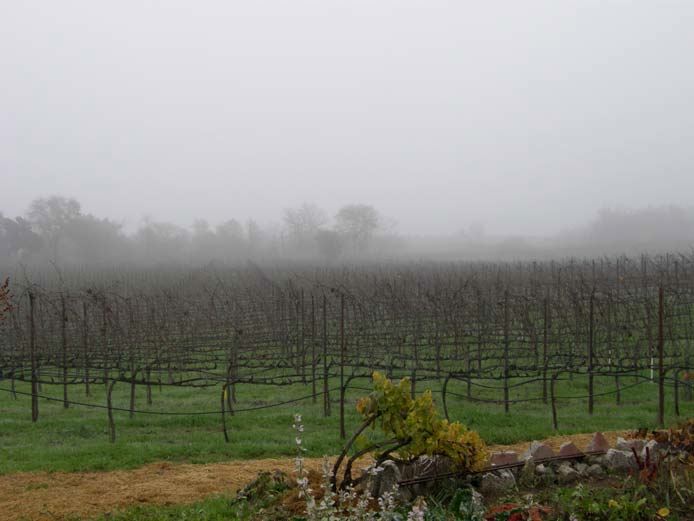
At the inaugural Green Valley Symposium in 2004, the characteristics of Green Valley Pinot Noir were detailed. Lively acidity is typical, what is termed “ice cherries.” The Pinot Noirs are closer in type to the Sonoma Coast than the Russian River Valley except that the tannins are less masculine. Bright, intense, ripe dark cherries, black plums, wild berries, cola, exotic spices, rich earth, zesty acidity, and silky tannins are the norm. If any criticism has been leveled at the Pinot Noirs from Green Valley, it is that they have lacked depth, and at times have been too austere. However, with the influx of multiple clones, including field selections such as Swan, planted in the proper sites, this shortcoming is becoming much less frequent. Green Valley Chardonnay presents a fresh, clean, crisp, Gravenstein apple, complex citrus flavor profile, with a core of minerality and great focus. The history of grape growing in the Green Valley predates the establishment of vineyards in Napa Valley. Historic records indicate 10 acres of vineyards were planted in the region by Russian immigrants in 1830. The vineyard acreage increased dramatically over the years until the 1870s when phylloxera and subsequently Prohibition intervened. The Green Valley would eventually become more known for apples and prunes than grapes. Modern viticulture began in Green Valley when Warren and Gail Dutton bought their first 35 acres west of the town of Graton in the 1960s. Their original family home is now the current Dutton Ranch offices. They began planting significant acreage near Graton just before the downturn in the apple industry. They were joined in the late 1960s by Rodney Strong, who, along with the Sterlings of Iron Horse fame, ignored the widespread opinion of the time that it was too cool to ripen grapes in the region. Today, the Dutton Ranch either owns, leases or manages more vineyard acreage in the Green Valley than any other grower. The Dutton Ranch now encompasses 1,300 acres (1,100 vineyards, 200 in apple orchards) in the Russian River Valley and Green Valley appellations (go to www.duttonranch.com for a map). Warren Dutton passed away in 2001 leaving Gail and sons Steve and Joe to carry on. Each brother now owns his own winery. Joe and his wife Tracy started Dutton Estate in 1994 and Steve and his wife Theresa founded Dutton-Goldfield Winery in 1998 with winemaker Dan Goldfield. The original Iron Horse Vineyard was planted to Pinot Noir and Chardonnay after Audrey and Barry Sterling acquired their 300 acre property on Ross Station Road in 1976. Rodney Strong had originally had an option to buy the property which had been planted to vineyards between 1971 and 1973. Forrest Tanzer, who was working for Rodney Strong at the time, became the Sterling’s winemaker, vineyardist and partner. Tanzer directed the upgrading and expansion of the 110-acre Iron Horse Vineyard which was the most westerly vineyard in Sonoma County at the time. A winery was built on the property and officially opened in 1979. Iron Horse Vineyards was the first to release a single-vineyard Green Valley bottling. Originally, most of the grapes grown in the Green Valley were picked early and used for making sparkling wine. Over the last fifteen years, there has been a shift to extending hang-time and the production of still wines. Pinot Noir and Chardonnay predominate, with smaller amounts of cool-climate Zinfandel, Syrah and Pinot Blanc being produced. The Green Valley viticultural area now has over 100 growers and 20 wineries. Some of the vineyards have become household names to pinotphiles including Arrendell Vineyard, Don Miguel Vineyard (Marimar Torres), Dutton-Freestone Hill, Dutton Morelli Lane, Dutton-Rued, Dutton-Thomas Road and Dutton-Widdoes vineyards, Emeritus Vineyards, Hallberg, Heintz Ranch, Keefer Ranch, and Orogeny Vineyard. The wineries include Atascadero Creek, Bpinot (Bybee) Vineyards & Habitat, Battaglini Estate Winery, Dutton Estate Winery/ Sebastopol Vineyards, Emeritus Vineyards, Freeman, Graton Ridge Cellars, Hartford Family Winery, Iron Horse Vineyards, Keefer Ranch, Marimar Torres Estate Winery, Occidental Road Cellars, Orogeny Vineyards, Patassy Vineyard, Peters Family Winery, Radio-Coteau, River Road Vineyards, Russian River Valley Vineyards, and Taft Street Winery. Dutton-Goldfield and Red Car will soon have facilities in the Green Valley as well. Among the several wineries leasing space in the former Vacu-Dry apple processing plant (now SonomaWest Industrial Park North) at the corner of Gravenstein Highway and Occidental Road, which is technically within the Green Valley appellation, are Adrian Fog Winery, Benziger Family Winery, Chasseur Winery, Kosta Browne Winery, Tandem Winery, WesMar Winery and Willowbrook Cellars. These wineries source grapes primarily outside the Green Valley appellation. Merry Edwards Winery and Paul Hobbs Winery sit at the eastern border of the Green Valley appellation. Among the wineries outside Green Valley that source grapes from the Green Valley appellation are A.P. Vin, Anthill Farms, August West, Benovia Winery, Barnett, Capiaux, DeLoach, DuMol, Dutton-Goldfield, EnRoute, Eric Ross, Gary Farrell, Guerrero-Fernandez Winery, Halleck Vineyard, Hess, Jordan (Chardonnay), Landmark Vineyards, LIOCO, Loring Wine Co., Lost Canyon, Lynmar, Martinelli Winery, Merry Edwards, Pali Wine Co., Patz & Hall, Paul Hobbs, Rhys Vineyards, Salinia Wine Co., Sequana, Scherrer Winery, Small Vines, Talisman, and Zepaltas. I recently sampled a number of Pinot Noirs from the Green Valley appellation. The overall quality was consistently high with many exceptional wines in the tasting. Green Valley is appearing on more wine labels as the consumer gains more insight into the special wines from this viticultural area. Green Valley is clearly a badge of distinction and an appellation designation worthy of displaying. And, it’s all due to a three letter word.
2008 OTP Of The Place Russian River Valley Pinot Noir 14.1% alc., 320 cases, Unreleased. From an unnamed prestigious vineyard in the Green Valley appellation. · A savory nose featuring plenty of oak. Dark red cherry and berry flavors with oak char in the background. Rich and brooding yet displaying some elegance. The pedigree of the fruit is evident but the oak steals the show at present. Decent (+).
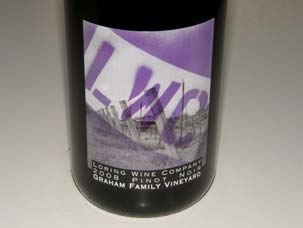 2008 Loring Wine Company Graham Family Vineyard Green Valley of Russian River Valley Pinot Noir 15.2% alc., $40, screw cap. · Penetrating and haunting aromas of red plums, red berries, violets and graham cracker. Really impressive and tasty sweet red berry attack that progresses to a memorable finish. This hedonistic, Caliesque sucker hangs around for at least half a minute. The fruit is startling good and the very smooth mouth feel brings the hair on your neck to attention. The alcohol is well integrated and the wine was still delicious the next day from a previously opened and re-corked bottle indicating the balance is spot on. This is a great sipping wine that aims to please.
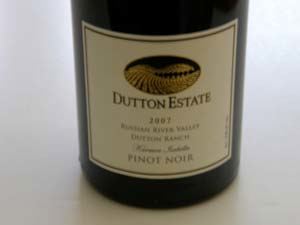 2007 Dutton Estate Winery Karmen-Isabella Green Valley of Russian River Valley Pinot Noir 14.9% alc., 625 cases, $30. · Wonderful aromatics featuring concentrated berry fruit with a hint of oak, herbs, spice, brown sugar and brioche. Tasty cherry and berry core with hint of spice. Lacks a little impression on the mid-palate but shows some persistence on the generous finish. Won’t disappoint at this price. Very good (+).
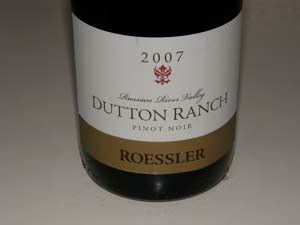 2007 Roessler Dutton Ranch Russian River Valley Pinot Noir 13.8% alc., 175 cases, $32. Sourced from the Thomas Road Vineyard in Green Valley planted in 1997 and farmed by Dutton Ranch. · Intense reddish-purple color in the glass. Subdued aromas of dark red fruits framed by toast and sweet smoke. A discreet and sensual wine offering strawberry and raspberry fruit with an underpinning of brisk acidity highlighted by a citrus peel note on the tangy finish. A great food wine. Fine the next day from a previously opened and re-corked bottle. Very good.
 2007 Bpinot (Bybee) Vineyards & Habitat Russian River Valley Pinot Noir 13.9% alc., 396 cases, $39. Crafted from organic grapes by winemaker Suzanne Hagen. Aged 10 months in lightly toasted French oak. Unfined and unfiltered. · Aromas of raspberry, strawberry, cherry, rosebush, grape must, redwood and spice draw you in, leading to a moderately rich dark red fruit core that is augmented by notes of loamy earthy, tea, herbs and soy. The flavor of Pinot grapes really comes through. Picks up richness with time in the glass. Harmonious and seductive with soft, ripe tannins. Very good (+).
2007 Capiaux Widdoes Vineyard Russian River Valley Pinot Noir 14.4% alc., $40. · Leads off with scents of black cherries, toasty oak and charcoal. Delicious aggressive attack of ripe cherries that are tar- and earthtoned. Nicely balanced with firm tannins and a moderately length finish. Soft in the mouth and aims to please but a little clumsy and doesn’t offer much nuance. Decent (+).
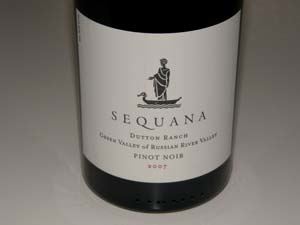 2007 Sequana Vineyards Dutton Ranch Green Valley of Russian River Valley Pinot Noir 14.9% alc., $40. Crafted by James McPhail. · Ripe aromas and flavors of strawberries, black cherries with a sidecar of sweet oak. Rich and luscious with a satiny mouth feel and gossamer tannins. Hard to say no to. Perfectly fine the next day from a previously opened and re-corked bottle. Very good.
2007 Failla Keefer Ranch Russian River Valley Pinot Noir 14.1% alc., $47. · The nose is dominated by purple fruits, mushrooms, oak and brioche. On the palate, the flavors echo the aromas with added interest offered by savory herbs. Smooth and full-bodied, even muscular, with silky tannins, good acidity and some persistence on the fruity finish. Decent.
 2007 Bpinot (Bybee) Vineyards & Habitat Sera Russian River Valley Pinot Noir 14.2% alc., 196 cases, $49. A reserve bottling primarily from Pommard clone grown in the estate vineyard that is organic and biodynamically certified. Aged 18 months in lightly toasted French oak. Unfined and unfiltered. · Very charming aromas of dark red berries, brioche and subtle oak. Lovely cherry and berry flavor that pack a wallop yet the wine is light on its feet. A dynamite wine that is well-dressed and ephemeral with supple tannins that allow for early drinking but possessing the balance to stay the course. The finish sails on for what seems like a minute. A special wine that you can spend the night with.
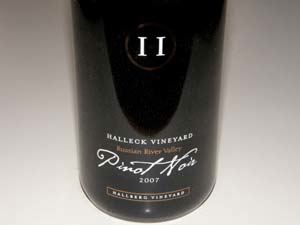 2007 Halleck Vineyard Hallberg Vineyard Russian River Valley Pinot Noir 14.2% alc., $55. · Shy but pleasing perfume of dark fruits. Earth-kissed fruits offer restrained lushness with good follow-through on the palate. A solid, fruit driven wine with admirable balance. Drink now. Very good.
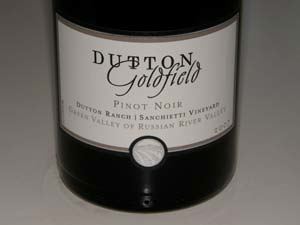 2007 Dutton-Goldfield Dutton Ranch Sanchietti Vineyard Green Valley Pinot Noir 13.5% alc., 345 cases, $58. · Now this is what I’m talking about. Nuanced and enticing nose featuring pretty aromas of red and black berry jam, crushed strawberries, wine cellar, vanillin and spice. Full-on attack of seductive berry fruit that is earthy and juicy leading to an aromatic and fruity persistent finish with a subtle kick of acidity. Very charming with velvety tannins, perfect weight and balance. This wine is a superb example of how you can craft great Pinot Noir at moderate alcohol levels. This wine shows the stamp of a gifted winemaker (Dan Goldfield).
2007 Dutton-Goldfield Freestone Hill Vineyard Russian River Valley Pinot Noir 13.5% alc., 537 cases, $58. · Fruity nose of grapes and berries with notes of spice and Coca-Cola. Lush, ripe and sweet mouth coating fruits with a long and powerful fruity finish. The tannins are restrained and the refreshing acidity makes the wine easily approachable now. Well-proportioned and nicely balanced. Very good.
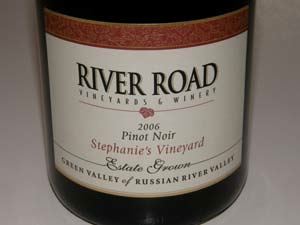 2006 River Road Vineyards & Winery Stephanie’s Vineyard Green Valley of Russian River Pinot Noir 14.1% alc., $16. Estate grown. · Moderately light color. Appealing scents of strawberries, cherries, spice and sassafras. Juicy flavors of cherries and berries, red hard candy and cola with very subtle oak playing a supportive role. Medium-light in body with gossamer tannins and respectable finesse. Closer to Russian River Valley in flavor. A terrific value. Very good.
2006 Patassy Vineyard Russian River Valley Pinot Noir 14.1% alc., $17. This vineyard is farmed by Frank and Stephan Patassy. It borders Atascadero Creek near Sebastopol. Aged 14 months in French oak. · Aromas of crushed, ripe strawberries, wet leaves and prune. A lighter and savory style featuring very ripe fruit flavors unusual for the Green Valley. Tastes of herbs and bourbon creep in. A value-priced daily drinker. Decent.
14.2% alc., $25. Estate grown and bottled from organically grown grapes. Unfiltered. · Aromas of strawberries, raspberries and wood shavings. The fruit veers to the redder spectrum with oak tannins playing a prominent role. Decent, but not exciting.
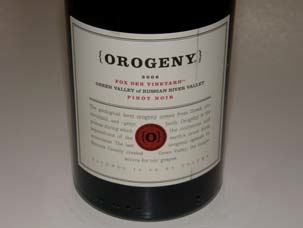 2006 Orogeny Fox Den Vineyard Green Valley of Russian River Valley Pinot Noir 13.7% alc., $34. From an 8-acre vineyard owned by Ed and Sue Smith. · Moderately dark reddish-purple color in the glass. Racy nose showing aromas of raspberry compote and spice. Complimentary flavors of strawberries, cranberries, raspberries, currants, and hazelnuts with an earthy underpinning veering a little toward overripeness. Hi-strung acidity with mild tannins and a smooth texture. Very good (-).
2006 Orogeny Green Valley of Russian River Valley Pinot Noir 14.1% alc., $34. · Berry jam, oak spice and new-mown hay aromas initially veering to green grass over time. Plush berry core that is somewhat flat and linear. Well-proportioned tannins and acidity but lacks a thrill. Decent.
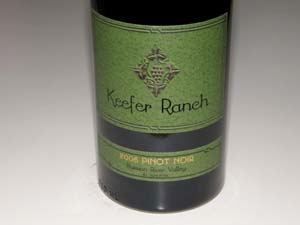 2006 Keefer Ranch Wines Russian River Valley Pinot Noir 14.2% alc., $42. Inaugural release. · Moderate reddish-purple color. Aromas of black cherries, strawberries, wet leaves, baking spice and oak are echoed in the flavors. Smooth, clean and elegant with balanced acidity and supple tannins. Perfectly fine and time to drink up. Very good.
2006 Martinelli Bondi Home Ranch Water Trough Vineyard Green Valley Pinot Noir 14.9% alc., $70. · The nose is loaded with oak toast and char which carries over on the palate. A rich core of dark fruits is quite pleasing but the toasted oak accent just doesn’t appeal to me. The wine drank much better the next day from a previously opened and re-corked bottle with more oak integration and a brighter display of fruit. At room temperature, the finish is a bit hot. Decent.
2005 Dutton-Goldfield Dutton Ranch Freestone Hill Vineyard Russian River Valley Pinot Noir 13.8% alc., 361 cases, $58. Located at the southwestern edge of Green Valley. Dijon clones. Very small yields with tight bunches and tiny thick-skinned berries. · Interesting aromatic profile of flowers, smoke, sap and oak. Earthy, grilled, smoky dark fruits with a hint of tobacco. Showing primarily secondary bouquet and flavors without the vibrant fruit shown on release, but will appeal to fans of aged Pinot Noir. Decent (+).
Other Green Valley-Russian River Valley Pinot Noirs worth consideration:
Cobb Wines: A RevelationThe Cobb Wines website says that they “produce exceptional and classic Pinot Noir wines reflecting the climate and soils of our coastal Sonoma County vineyards in North California.” I could not have said it better! I met David Cobb and his winemaker son Ross at the International Pinot Noir Celebration in 2008 and their wines that were poured then impressed me. Somehow I never got around to revisiting them and after recently tasting through several 2006 and 2007 Cobb Pinot Noirs, I realized I had been missing out on remarkably good Sonoma Coast wines brilliantly crafted in a graceful style. These wines are very close in style and character to the Williams Selyem Pinot Noirs of the early 1990s and deserve a place in every Pinot lover’s cellar. Cobb Wines is a Pinot Noir specialist focusing on single-vineyard wines that was established in 2001 by Stephen and Ross Cobb and their parents David and Diane Cobb. David Cobb owns and farms the 15-acre Coastlands Vineyard and oversees all the vineyards from which the winery sources grapes. David began growing Pinot Noir at the sustainably farmed Coastlands Vineyard back in 1989 at a time when the only vineyard neighbor in the extreme westerly location four miles from the Pacific Ocean was Summa Vineyard. He was a marine ecologist by trade, but studied soils and climatology for years before finding a suitable site on the ridge tops of the Sonoma Coast. The fruit from Coastlands Vineyard was sold to Williams Selyem until 2001. Ross Cobb, who studied soil science and sustainable agriculture in college, spent time at Ferraro- Carano Vineyards and Winery and Bonny Doon before he was hired by Burt Williams at Williams Selyem. He took a serious liking to Pinot Noir and eventually became the winemaker at Flowers from 2004 to 2008. Today, he is the accomplished winemaker for Cobb Wines. Ross and his father started out make a little wine of non commercial Pinot Noir from Coastlands Vineyard. The first vintage of commercial Coastlands Vineyard Pinot Noir in 2001 yielded 130 cases. Besides Coastlands Vineyard and the special block within known as Coastlands Vineyard Diane Cobb, the Cobbs source grapes from four other independently owned vineyards located in the western Sonoma Coast appellation and primarily in the Freestone-Occidental region that has become an epicenter for exceptional Pinot Noir. Each of the vineyards offers distinct soil types, different microclimates, and a diverse combination of clones and rootstocks resulting in unique expressions of Sonoma Coast terroirs. These vineyards include Rice-Spivak Vineyard, Joy Road Vineyard, Jack Hill Vineyard, and Emmaline Vineyard.
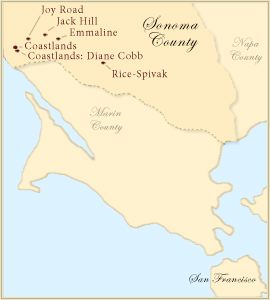 This was the first winery in California I have ever reviewed in which each wine in the tasting lineup deserved my highest accolades. Extraordinary consistency to say the least! Every wine had the whole package: charming aromatics, seamless and smooth textures, moderate alcohols, alluring elegance, and impeccable balance. I can’t emphasize the stunning aromatics enough. It is evident David and his son, Ross, are tuned into Pinot Noir. They nurture Pinot Noir properly in the vineyards, and pick the grapes when they are just nudging ripeness. The moderate alcohols and flavors reflect this approach. The wines are not inexpensive, but completely justified in my mind as they are in the very top echelon of premium California Pinot Noir.
2007 COBB Coastlands Vineyard Sonoma Coast Pinot Noir 13.9% alc., 240 cases, $68. This 14.5- acre vineyard is owned and farmed by the Cobb family and contains some of the oldest Pinot Noir vines on the Sonoma Coast. A very cool site near Occidental, this is one of the last vineyards to ripen on the Sonoma Coast each season. Several clones including Pommard, Martini, Wädenswil and Mt. Eden planted on various rootstocks. Yorkville and Kneeland loamy soils. · More intense color than other wines in this lineup. Aromas of plum sauce, soy, poki, dank cellar and sandalwood. Dancing mix of purple fruits, earth and oak flavors carry through to a remarkably persistent finish. Intensely fruity and seemingly a little closed at this time. Keep this one in the cellar a few years.
2007 COBB Joy Road Vineyard Sonoma Coast Pinot Noir 13.8% alc., 240 cases, $68. A 2.5-acre vineyard owned by winemaker Terry Adams located a short distance from Coastlands Vineyard on a 1,300-foot ridge top near Occidental. Planted in sandy loam to four different varieties of Pinot Noir. · The nose is both savory and floral along with earthy cherry and berry fruits that are quite vivid. Delicious redder-toned fruits with supportive oak pulled into line with fine acidity. A middle weight wine that is soft and sensual in the mouth departing with a taunting, teasing and lingering aroma of fresh cherries.
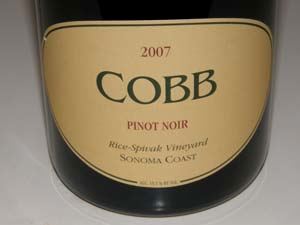 2007 COBB Rice-Spivak Vineyard Sonoma Coast Pinot Noir 13.3% alc., 360 cases, $68. · Like the 2006 version of this wine, this is a remarkable drink. Very expressive fruity nose emphasizing berry tart, the slightest oak and a hint of spice. Flavors of redder-toned berry fruits fan out softly on the palate, saturating every corner of the mouth and fading lithely in a lingering finish with a pleasing grip of acidity. Seamless in every way, urging you to reach for another sip. A little richer tasting than the 2006 vintage even at a lower alcohol. This vineyard is one fine piece of dirt.
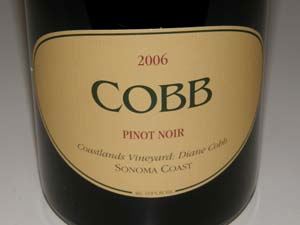 2006 COBB Coastlands Vineyard Diane Cobb Sonoma Coast Pinot Noir 13.9% alc., 145 cases, $72. A 1.5-acre block in the Coastlands Vineyard planted to a single Pinot Noir variety chosen by Diane Cobb through her work with a nursery block at Coastlands that contained over 20 relatively unknown Pinot Noir varieties. This wine commemorates Diane’s life at Coastlands from its founding in 1989 until her death in 2006. · Subdued aromas upon opening, but becomes quite expressive over time in the glass. Pleasing perfume of fresh berry jam, Morrocan spices and a little barnyard. Intense black cherry and strawberry flavors like bombs bursting in the mouth. Earth and hard red candy accents add interest. Juicy and charming with a finish that would make Hollywood proud.
2006 COBB Emmaline Vineyard Sonoma Coast Pinot Noir 12.8% alc., 166 cases, $72. This 3-acre vineyard is at the western margin of Sebastopol near Occidental and receives more shade and fog than the other Cobb vineyards. The Goldridge sandy loam soils are planted to Dijon 115 and 777. · Pleasing scent of dark stone fruits nicely spiced. An array of brambly fruits show up in the mouth including ripe strawberries, blackberries and plums. Smooth and silky with bright acidity and fine, ripe tannins create no rough edges. Truly unique from the other Cobb bottlings.
2006 COBB Rice-Spivak Vineyard Sonoma Coast Pinot Noir 13.8% alc., 495 cases, $72. 6-acre vineyardowned by Russell Rice and his wife, Dr. Helen Spivak. Goldridge sandy loam with ash. Dijon and Swan clone. · Stunning aromas of bright and pure cherries and berries with a hint of forest floor. Only Pinot Noir can offer a nose like this. Luscious attack of red and black cherries and berries on the mid-palate with an appealing accent of earthy loam and smoke lifted with balancing acidity (dare I say minerality), and caressed by fine-grain tannins. Elegant and refined all the way through to the vibrant and pleasing finish. This is a great wine that really shows off the frilly, sexy side of Pinot Noir.
Cobb Wines are allocated through a mailing list and are available online at www.cobbwines.com. The wines reviewed above are still available. Production in 2007 was just under 1,400 cases of Pinot Noir.
Big Table FarmThe Oregon wine industry was founded on California ex-patriots including David Lett, Dick Erath and Dick Ponzi. Winemaker Brian Marcy and his artist spouse, Clare Carver, are Napa, California transplants who are carrying on the tradition. They bought property in the Willamette Valley in the town of Gaston (an hour's drive southwest from Portland) to start a winery and plant a vineyard. They launched their cleverly anointed label, Big Table Farm, in 2006, crafting wine from purchased grapes. Brian is a young, but experienced winemaker, who studied fermentation science at University of California at Davis and has had winemaking stints at Turley Wine Cellars, Neyers Vineyards, Blankiet Estate and Marcassin in California. Clair is an accomplished painter and graphic artist who has won multiple awards for wine labels she has designed. She has created labels for over 50 wineries from Oregon, California and Washington. The Big Table Farm labels are quite unique, simply portraying farm animals such as Joleen the pig on the Willamette Valley Pinot Noir and Josephine the cow on the Resonance Vineyard Pinot Noir. The labels were made by hand, using a letterpress and thick printmaking paper, then hand cut and glued on each bottle. Besides making wine, the couple have established a working farm where they raise poultry, pigs, cows and egg-laying chickens and keep a large garden. See the photos of the free range chickens, porkers and cattle on the website at www.bigtablefarm.com. The name, Big Table Farm, reflects the owners' desire to provide a welcoming table for themselves and their friends, laden with artisan foods and wine: “eat, drink and enjoy.” I met the couple at this year’s Pinot Days Southern California and was impressed not only by their enthusiasm for wine but the outstanding quality of their wines. In this age of so many mass-produced wines, the Big Table Farm stands out as a truly personal, artisan producer displaying remarkable talent, joie de vivre, and admirable commitment to sustainable farming traditions. This is exactly the type of winery we want to, need to, have to support.
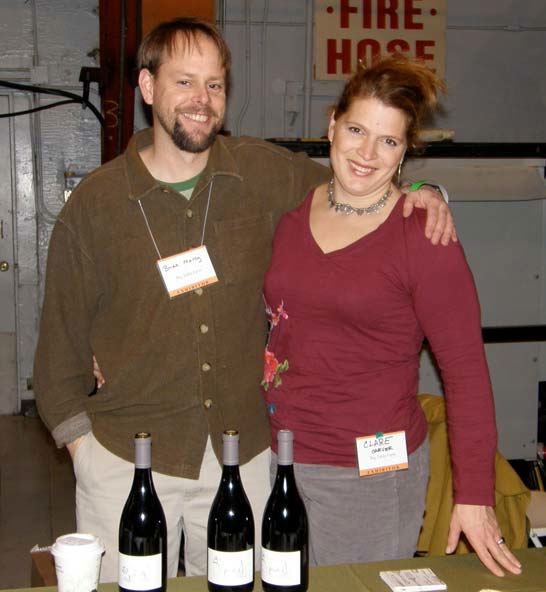
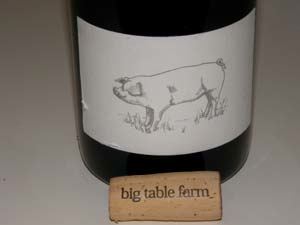 2008 Big Table Farm Willamette Valley Pinot Noir 13.2% alc., 77 cases, $38. This blend is primarily sourced from the Johan Vineyard, farmed by Dan Rinke. The vineyard is organically farmed with the goal of obtaining biodynamic certification. The manure from cows at Big Table Farm is used for preparations for the vineyard rows that are tended for Big Table Farm. · Moderate garnet color in the glass. The aromas of cherry/berry jam, roses and red jujubes are enticing. Discreet structural power with vivid berry fruit that is subtly spiced and smoked. A middle weight wine displaying a soft and smooth mouthfeel, fine-grain tannins and impeccable balance. A very impressive Willamette Valley bottling. Very good (+).
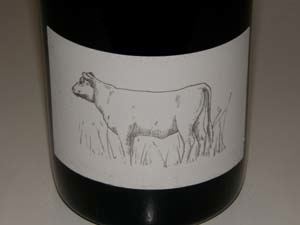 2008 Big Table Farm Resonance Vineyard Yamhill-Carlton District Pinot Noir 13.1% alc., 94 cases, $45. This vineyard is farmed by Kevin and Carla Chambers and is certified Biodynamic®. · Rich, deep, brooding dark red fruits with a savory underpinning of chanterelle mushrooms, loamy earth and cardamon spice. This wine has impressive intensity on the mid palate, a pillowy texture, and a finish like a three hour movie you don’t want to end. Still a little closed, seemingly possessing more hidden charm waiting to get out. Cellar this wine for one to two years for ultimate gratification. Love the low alcohol. A very heavenly and sensual pleasure.
Visit the informative and beautifully designed website at www.bigtablefarm.com. The wines are available online, but with such small production, I am sure they will quickly sell out. A Riesling and Syrah are also produced.
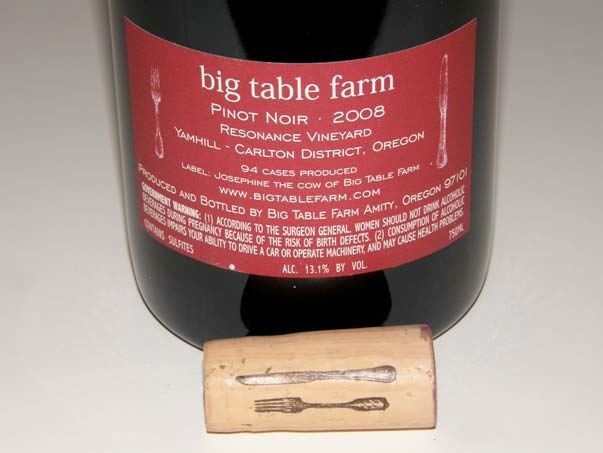
Williams Selyem: A California IconI look back on the early 1990s and remember liking California Pinot Noir practically labeled me an eccentric. To most wine lovers of the time, Pinot Noir was an afterthought, a weak substitute for Cabernet Sauvignon and Merlot. For me, Pinot Noir was the Holy Grail, the most sensual of all wines, and I was staunchly determined to pursue my love affair with it. It was the Pinot Noirs of Williams Selyem that culminated my courtship. Burt Williams and Ed Selyem were able to produce magical Pinot Noirs out of a small garage on Fulton Road in Santa Rosa. The original Pinot Noir garagistes, they crafted magical wines from vineyards that are now revered like Rochioli, Allen, Hirsch and Olivet Lane. It was a 1992 Williams Selyem Rochioli Vineyard Pinot Noir that made such a powerful impression on me that even today I can taste the wine, and clearly believe it was the greatest California Pinot Noir I have ever had in my life. Burt Williams lived in Forestville, worked as a printer for the San Francisco Newspaper Agency (the Chronicle and Examiner), and made wine at home. Ed Selyem was a wine buyer and salesperson who crafted beer and fruit wine in his garage in Forestville. Together, they began making wine from Sonoma Zinfandel grapes for their own use in 1979. They started making wine commercially in 1981 at Russian River Valley Vineyards in Forestville and bottled the Pinot Noirs under the Hacienda del Rio label, a name Ed used on his first home-crafted wines. The photo below on the left shows a 1980 Hacienda del Rio label from a wine produced in Burt's Forestville garage but not released commercially. The 1981 to 1983 Hacienda Del Rio label looked exactly like the current Williams Selyem label, using the same letterpress letters, color and paper (below right). A complaint from Hacienda Winery prompted the partners to drop the original name and substitute Williams Selyem beginning with the 1984 vintage. In 1984 they had moved to a rented garage on River Road in Fulton, becoming true "garagistes."
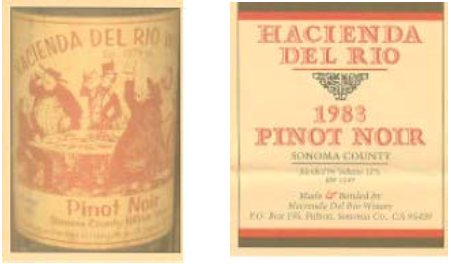 Williams was a burly vintner who had a superb palate and an uncanny and self-taught sense of how Pinot Noir should be vinified (photo below left). He never set foot in Burgundy. Early on, production methods were old fashion and labor intensive due to a lack of capital. In the early years, Williams continued his job in San Francisco as did Ed at Speer’s Market in Forestville, and they took vacations at crush time to make the wines. They began with little money, never borrowed, and grew 25% every year by starting small and plowing all of their income back into the business. Spouses Gayle Selyem and Jan Williams were also partners in the winery which early on hired no outside help. It was a perfect business partnership with Burt driven to make world-class wine and Ed determined to create a successful business from local agriculture. Burt preferred colorful sport shirts with suspenders, Ed opted for tee shirts and boots. Both lived simply and shunned publicity. There was never a sign at the garage announcing the winery’s location, and there was never a tasting room. The secret to their success, and this has become the model for all prestigious producers of California Pinot Noir today, was to carefully chose their grape sources and perform all the work in the winery themselves. Over time, North American vintners have come to realize that Pinot Noir requires delicate handling and constant vigilance in the winery, two things Ed and Burt practiced from the beginning. Their winemaking techniques were very labor intensive, but the result justified the effort. The Williams Selyem Pinot Noir were brimming with varietal character, and although light in color, they had superb aromatic and flavor intensity.
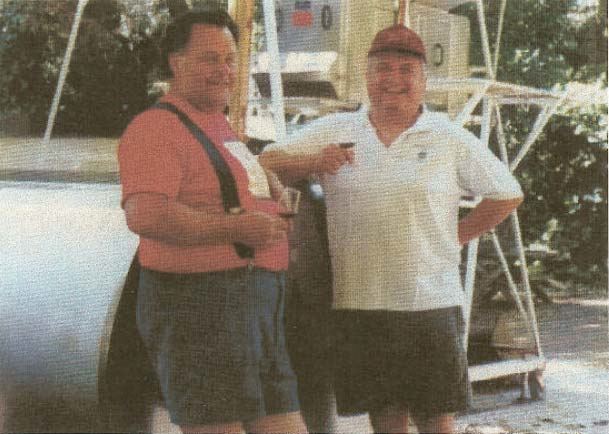 The more wine Williams Selyem made, the more favorable the press that followed, causing a snowball effect in demand. The 1985 Williams Selyem Rochioli Vineyard Russian River Valley Pinot Noir became the most seminal wine in the history of California Pinot Noir. This wine won the Sweepstakes at the California State Fair Wine Competition, voted the best of the 2,136 wines entered by 416 wineries in 1987. 295 cases of this wine were produced and it sold for $16 a bottle. Williams Selyem became so popular that a waiting list was developed for those begging to get on the mailing list. Eventually, 85% of the wine was sold directly to individuals on the carefully guarded mailing list. Ed managed the list masterfully and enjoyed being in contact with, visiting with, and learning from devoted customers. The customers were among the most devoted of any other winery I have experienced then and now. Chris Crevasse of Tennessee wrote, “We are a little concerned about my brother-in-law, who had never tried world-class wine until we shared a bottle of your 1991 Olivet Lane Pinot Noir with him. Now he’s lost interest in work and has moved the La-Z-boy downstairs in the wine cellar. He claims he just wants to watch, but it’s hard to say what need watching down there. We’re all hopeful that he’s just displaying the initial zeal of a new convert, and that he return to a more normal life once he gets accustomed to venerating your wine.” Williams Selyem Pinot Noirs were amazingly fruity and complex when young and seemed to age better than most California Pinot Noirs of the time. The wines peaked around 6 to 7 years after release, but it was difficult to avoid drinking them young. The unlikely owners and the scarcity of their wines created a mystique, but it was the wines’ quality and consistency that was the attraction. Win Wilson and Jack Daniels, the Napa Valley importers of Domaine de la Romanee-Conti came calling to Williams Selyem in 1992. They wanted to compare wines. 22 wines and 5 hours later, no conclusions were publicly reported, but the reason to do such a comparative tasting indicated the cachet that Williams Selyem had gained with the wine industry. The popularity of Williams Selyem wines took its toil over the years on Ed and Burt. Managing the mailing list and the hoards of wine enthusiasts trying to get on the list became a daunting task. Two of the winery’s seven full-time employees in the mid 1990s were designated as “keepers of the list,” and devoted their work day to managing it. The partnership slowly developed some rife and Williams Selyem was put on the market in 1997. It was sold to John Dyson, a long time member of the Williams Selyem mailing list in 1998 for a reported $9.5 million. The official word was that Ed developed serious back problems from lifting cases of wine over the years, but the reasons had to be more complicated, yet were never divulged. The last vintage that Ed and Burt vinified at Williams Selyem was 1997, with Burt consulting on the 1998 vintage. At the time the winery was sold, there were 10,000 customers on the mailing list and many more on the waiting list. John Dyson, a wealthy New York politician, was a former New York State agriculture commissioner and a former deputy mayor under Mayor Rudy Giuliani. He owns Millbrook Vineyards in upstate New York and Villa Pillo Estate in Tuscany as well as Mistral and Vista Verde vineyards on the Central Coast of California. Dyson essentially paid a fortune for the Williams Selyem name only since Ed and Burt did not own vineyards or a physical winery. Dyson lost some of the hand shake agreements that existed for grapes from Olivet Lane Vineyard, Summa Vineyard, and Rochioli’s West Block, but several of the vineyard sources such as Allen Vineyard, Ferrington Vineyard and Hirsch Vineyard were retained. Upon purchasing the winery, Dyson hired the relatively unknown winemaker, Bob Cabral. Cabral, who was Williams Selyem customer number 576 on the mailing list, was the son of grape farmers. He had earned a degree in enology at California State University at Fresno and learned his trade at DeLoach Vineyards, Knude, Alderbrook, and Hartford Court. Since assuming winemaking responsibilities, Cabral has followed many of Williams’ winemaking methods. After an inauspicious start (it is always difficult to follow a legend), he is producing an exceptional lineup of appellation-based and vineyard-designated Pinot Noirs that are still eagerly sought after. The wines are now a little higher in alcohol, deeper in color, and offer more intense fruit-driven flavors, but they have received consistent praise from the wine press and the winery continues the tradition of excellence began almost thirty years ago. Finishing touches are being applied to the new Williams Selyem production facility at the Litton Estate on Westside Road. Crush activities still take place at the nearby Allen Ranch but the production barrel rooms that are built into the hillside are finished and the bottling line was in place for the 2008 vintage. Solar panels supply much of the winery’s electric power and rooftop gardens help insulate the new building. I recently tasted through most of the lineup of the 2007 Williams Selyem Pinot Noirs. These wines have now spent some reasonable time in the bottle allowing for proper critical evaluation. The wines met all of my preconceived expectations considering the accolades bestowed on the 2007 vintage, This vintage was recently declared “Vintage of the Decade” by Wine Enthusiast magazine, whose Pinot Noir wine reviewer, Steve Heimoff, awarded the 2007 Williams Selyem Litton Estate Vineyard Russian River Valley Pinot Noir ($100) a score of 100, matching its price, becoming the first California Pinot Noir ever given such a lofty score. The 2007 growing season in California was marked by moderation and evenness. Bud break was uneventful in March, the summer was warm and sunny with very few heat spikes resulting in uniform ripening. The harvest of Pinot Noir began in early September and was interrupted by fog and cool weather in the middle of the month, followed by a leisurely paced harvest of the rest of the crop which benefited from the extended hang time. According to Williams Selyem,”In a decade of exceptional vintages, this one really stands above all others.” I did not review the Litton Estate Pinot Noir from a winery-owned 19-acre vineyard or the Central Coast, Sonoma Coast and Sonoma County bottlings. The wines were all darkly colored with admirable balance, excellent integration of oak, and appealing aromatics. They are solid wines, and while several stir emotion, a few don’t deliver at the price point.
2007 Williams Selyem Russian River Valley Pinot Noir 14.1% alc., $45. Primarily sourced from the winery’s Drake Estate Vineyard planted in 1998. Pommard and Dijon 115. · Heady aromas of Bing cherries, cola and baking spice. Reasonably concentrated flavors of dark red cherry and berry fruit which build in intensity in the glass. Very pleasing in the mouth with soft tannins and a crisp finish. Very good.
2007 Williams Selyem Bucher Vineyard Russian River Valley Pinot Noir 13.9% alc., $54. · Marvelous spiced Bing cherry aromas predict greatness but the wine deliver flavors with a disappointing message. The cherry core is dominated by an earthy, savory, woody imprint that just wasn’t to my liking. Decent.
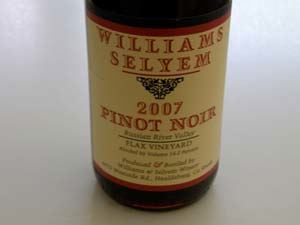 2007 Williams Selyem Flax Vineyard Russian River Valley Pinot Noir 14.2% alc., $54. · A signature Russian River Valley Pinot nose perfumed with nicely spiced berry and cherry compote with an echo of oak. Very tasty panoply of red berries and cherries intensely composed like a flavorful liquor. Juicy with a smooth viscous mouth feel, supple tannins and perfect balance. A great wine that reminds me of old vintages of Williams Selyem and one of my favorites in this lineup.
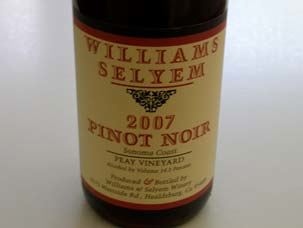 2007 Williams Selyem Peay Vineyard Sonoma Coast Pinot Noir 14.3% alc., $54. · The nose lack sensory impact but offers demure aromas of redder fruits and crushed rocks. Elegantly composed and shy in generosity of flavor but offering pleasing notes of dark red cherries and cranberries, mocha and spice. Has the balance to age and certainly will become more expressive with time in the cellar. Very good (+)
2007 Williams Selyem Vista Verde Vineyard San Benito County Pinot Noir 13.9% alc., $54. · This wine offers an interesting array of scents including fresh berries, black currants, vanillin oak and stem. Moderately rich middle palate of cherry and berry fruit with a hint of citrus bringing up the rear. Bright and juicy with moderate persistence on the finish. Solid but not spectacular. Very good in this vintage.
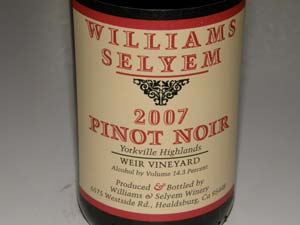 2007 Williams Selyem Weir Vineyard Yorkville Highlands Pinot Noir 14.3% alc., $56. · This wine takes on more muscle and interest with time in the glass. The nuanced aromatic profile features dark stone fruits, spice, oak and toast. Deep, dark but charming fruit is wrapped in firm tannins and balanced acidity. A virile wine of great intensity that has multiple layers of fruit and perfect harmony.
2007 Williams Selyem Ferrington Vineyard Anderson Valley Pinot Noir 13.9% alc., $62. · Simple perfume of crushed cherries, berries and sweet oak. A rich, full-bodied and tasty fruit-driven wine with a little acidic tang on the finish. The tannins are reigned in creating a silky drinking experience. A bit one-dimensional but the sappy fruit flavors will find many fans. Very good.
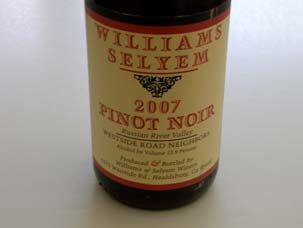 2007 Williams Selyem Westside Road Neighbors Russian River Valley Pinot Noir 13.8% alc., $67. A complex blend from the best growers on Westside Road including Allen, Bacigalupi, Bucher, Flax, Rochioli Riverblock and Litton Estate. · Brooding aromas of dark stone fruits, spice and vanilla. Opens somewhat in the glass but never offers a big dose of fruit. Full-bodied, magnificently flavored core of cherries, cranberries, and raspberries pulled into line by fine acidity and ripe tannins with a subtle accent of sweet oak. A little closed and not what it will be. Decant if you must drink now. Very good
2007 Williams Selyem Coastlands Vineyard Sonoma Coast Pinot Noir 14.3% alc., $69. · Very dark reddish-purple color in the glass. Intense aromas of blackberries, black plums, Indian spices, loamy earth and green garden with a hint of alcohol peaking out. Unctuous, tannic, rough hewn and muscular on the attack featuring smoky dark fruits and a citrus underpinning. Needs food, preferably short ribs. Decent.
2007 Williams Selyem Hirsch Vineyard Sonoma Coast Pinot Noir 14.3% alc., $72. · Starts off strong in the glass with alluring floral and red berry scents, fading over time revealing more savory, earthy accents. Delicious and generous lasting flavors of deep red cherries and berries pulled into line with fine grain tannins and bright acidity revealing itself in a citric peel highlighted finish. Not a huge or loud wine, but very satisfying. Very good.
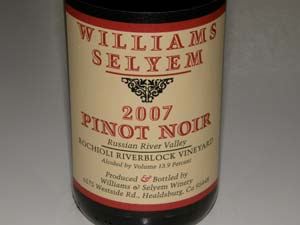 2007 Williams Selyem Rochioli Riverblock Vineyard Russian River Valley Pinot Noir 13.9% alc., $75. · Very alluring scents of cardamon spice, rose petals and Bing cherries. An impressive wine with a discreetly concentrated cherry and berry core augmented with Xmas spice, vanilla and an undertone of minerality. The silky texture is dreamy and the overall impression is one of purity, vibrancy and harmony. This is clearly the class of the lineup and will definitely find a place on my 2010 All American team.
2007 Williams Selyem Allen Vineyard Russian River Valley Pinot Noir 13.8% alc., $78. · Subdued aromas of wild berries and plums. Earth-laden dark fruits with a hint of tea and root beer. Rich and husky but not showing much chutzpah now. Smoothly textured and well-crafted but dull. I expect more from this bottling and perhaps it will improve with time in the cellar. I didn’t have a second bottle to sample. Decent (+).
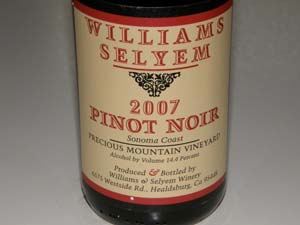 2007 Williams Selyem Precious Mountain Vineyard Sonoma Coast Pinot Noir 14.4% alc., $90. · Delicate aromas of dark stone fruits and blackberries. A hulk of a wine with prodigious dark fruit that coats the mouth with intensity. A wonderful sipping wine that will charm any big fruit lover. Hard to keep you hands off now, but cellaring will provide dividends down the road. This wine definitely stands out from the pack.
Williams Selyem wines are primarily sold to an eager and faithful mailing list of customers. With the recent economic downturn, some of the wines have been more available to those not on the mailing list (inquire by phoning the winery). The wines are readily available on the secondary market at a small premium over the release price. There are two offerings. The spring offering brings primarily the appellation Pinot Noirs and Westside Neighbors bottling while the fall offering includes all the single-vineyard Pinot Noirs. High quality Chardonnay and Zinfandel are also produced. The informative website is at www.williamsselyem.com. Maps of all the sourced vineyards are included. Videos of Russian River Valley pioneers are also offered including interviews with Howard Allen, Helen and Charles Bacigalupi, Jim and Andrew Forchini, and Joe Rochioli. The James Beard winning video on the Russian River Valley produced by Grape Radio is also available for viewing.
Canihan Family Cellars: Little Known But Highly AwardedThe Canihan family acquired a 20-acre vineyard property on the southern edge of the Sonoma Valley bordering Carneros in 1975 from a Basque farmer, but planting did not ensue for 23 years. Bill Canihan and his father, William Canihan, Sr., were inspired by a member of the family, August Sieguist, who had sustainably farmed a vineyard planted to Pinot Noir and other cool climate varieties in his native Switzerland before immigrating to the United States in the early 1900s. The Canihans sought out noted viticulturist Phil Coturri to direct the planting of the vineyard and winemaker Alexandra Romanini to assist them initially in producing Syrah, Cabernet Franc and Pinot Noir from their vineyard. Bill now works with winemaker Alex Beloz, formerly of MacRostie Winery. The inaugural Canihan Family Cellars release, a 2004 Estate Syrah, won Best of Show Red Wine at the prestigious 2007 San Francisco International Wine Competition. The Canihan Family Cellars 2005 “Exuberance” Pinot Noir won Gold Medals at the 2008 San Francisco Chronicle Wine Competition and the 2008 West Coast Wine Competition. Quite a burgeoning resume for a very young winery. The Pinot Noir portion of the estate vineyard is composed of 3.75 acres planted to Dijon clones 115, 667 and 777 and newer 3.61-acre plantings that include the same Dijon clones and Pommard, 2A and Wädenswil clones as well as Paul Masson, Swan and Hanzell selections. Dry farming and cane pruning result in small yields of less than 2 tons per acre. The vineyard is ideally located to receive the full affect of the cooling fog and maritime breezes from nearby San Francisco Bay. The Canihans are committed to farming sustainably and biodynamically and the vineyard is certified organic by CCOF. Canihan Family Cellars was one of Crushpad’s first commercial customers. Now the wines are crafted in a warehouse complex near the town of Sonoma, the home of many other well-known producers of Pinot Noir. I recently visited Bill at his winery and tasted his current releases that he was pouring like a proud new father. I also spent some time with the wines at home and felt they warranted your attention.
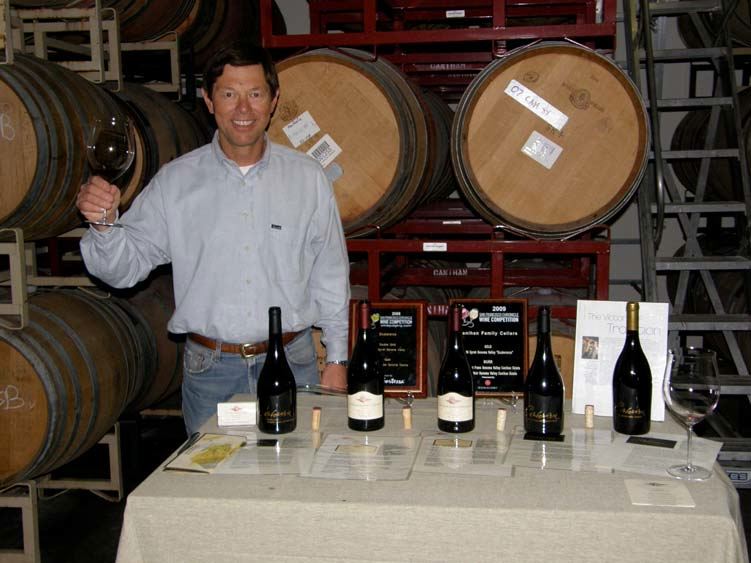
 2007 Canihan Family Cellars Sonoma Valley Pinot Noir 14.0% alc., pH 3.72, 290 cases, $39. 100% Estate Grown. Yields were less than 1.5 tons per acre. 80% Dijon clones. Unfined and unfiltered. · Enticing aromas of cherries, strawberries, green tea and baking spices. Delicious essence of the same fruits settle on the middle palate accented by savory herbs, brown spice, and vanilla wafers. Discreetly rich with admirable finesse and a moderately long, teasing finish. This is a wine you keep going back to. Shows a kinship to Russian River Valley Pinot Noir. Ready to drink now but balanced to last several years.
 2007 Exuberance Sonoma Valley Pinot Noir 14.2% alc., pH 3.69, 120 cases, $60. This is a reserve bottling only produced in exceptional vintages. 100% Dijon clones 115, 667 and 777. · Moderately dark reddish-purple color in the glass. Rich and deep nose of dark stone fruits and berries with hints of smoke, oak and herbs. Luscious silky purple fruit core that is toasty, herbed, and rich but not cloying. The silky smooth texture grabs your attention. Still somewhat primary and lacking nuance, this wine has the stuffing for greatness down the road. A reserve in every sense of the word. Very good.
Canihan Family Cellars wines are available on the website (www.canihanwines.com) and through retail channels primarily in Northern California. Call Bill for a tasting appointment (415-929-8190).
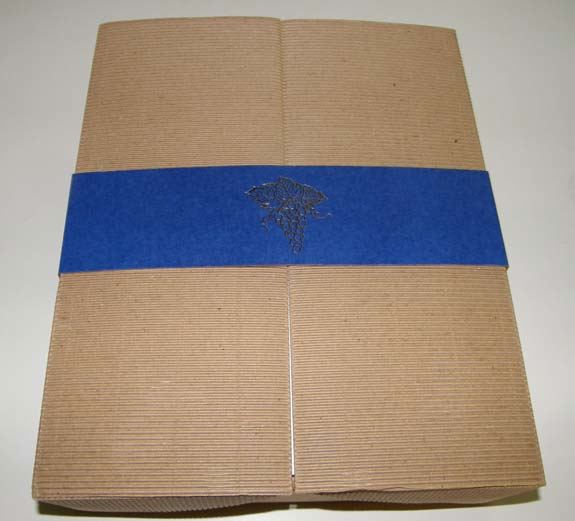
Pey-Marin: Carrying the Flag for Marin CountyThere isn’t much Pinot Noir planted in Marin County (less than 150 acres), but the wines made from this region are distinctive and worth searching out. Marin County borders Sonoma County to the North and the climate is similar to the Sonoma Coast. Influenced by two bodies of water: the Pacific Ocean along Marin’s western coast and San Pablo Bay along the eastern border, Marin winegrower Jonathan Pey points out that Marin’s winters are warmer than neighboring Napa and Sonoma because of extremely high winter precipitation. This leads to accelerated bud break, but Marin’s persistently cool weather in the spring and summer and complete lack of heat spikes push flowering, set, and harvest many weeks beyond other cool climate regions. The hang times are among the longest in California. Because of the long growing season, wines from western Marin, (Pinot Noir and Riesling are the focus), have superb natural acidity and generally lower alcohol levels. When nature cooperates, western Marin County can produce very small Pinot Noir berries with high skin to juice ratios that yield wild and concentrated flavors. Growing Pinot Noir in Marin County is not for the faint of heart. The few vineyards hold considerable potential when the weather cooperates, but small, even minuscule yields, are often the rule. Jonathan calls the yields, “Stupid - pick a low number!” The soils are decomposed marine sediment and drain beautifully. Jonathan and Susan Pey are winegrowers and residents of Marin County who have a shared passion for wine. Jonathan has had a distinguished career in the ultra-premium wine industry at Domaine Louis Jadot, Penfolds, and Robert Mondavi Vineyards. Susan is a wine buyer for a large prestigious restaurant group in the Bay Area. Together they launched their own line of wines in 1999, producing superb Pinot Noirs and Rieslings under the Pey-Marin label. The Peys lease and farm part of three vineyards in Marin County: Pey-Marin block at Corda Vineyard, a block at Stubbs Vineyard, and a block at Kendric Vineyard. The three sites are quite diverse with differing slopes, orientation, clones, rootstocks, age, and harvest dates. Pey-Marin block is nearly 20 years old, and Stubbs and Kendric are over 10 years old. Jonathan crafts a single Pinot Noir from these sources labeled “Trois Filles,” as a loving gesture to the Pey’s three daughters. I have been a fan of these wines since 2002 and recently tasted through several vintages as reported here. Because of the limited grape sources in Marin County, recently the Peys launched additional labels, Pey-Lucia, “Frisquet” Pinot Noir from the Santa Lucia Highlands and The Forager Pinot Noir sourced from three diverse regions (Santa Lucia Highlands, Marin County, and Sonoma Coast - $25). The umbrella company for the Pey’s winemaking ventures is Scenic Root Winegrowers.
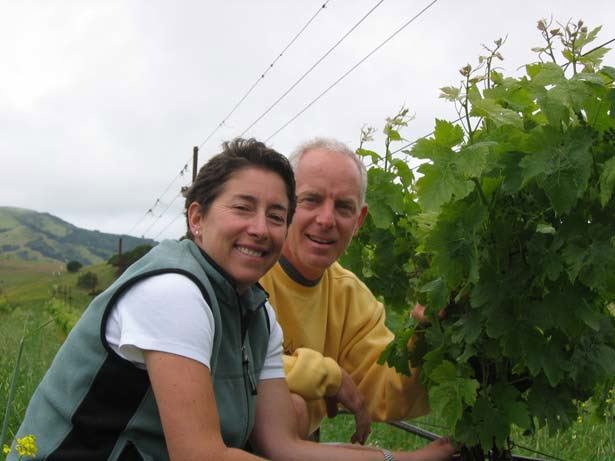
Pay particular attention to the 2007 vintage wines. Jonathan said, “The 2007 vintage made life pretty easy in the vineyards, and the fruit arrived in really nice shape. Yields, well.......there is always next year!” He went on to say, “The vintage is ripe and bright and the wines should evolve nicely over time.”
2002 Pey-Marin “Trois-Filles” Marin County Pinot Noir 13.5% alc.,120 cases, $29. · Shy but pleasing fruit aromas with notable oak char and cigar box. Dark cherry and berry and fig flavors accented by notes of spice and tobacco backed by fine grain tannins leading to a persistent cherry lift on the finish. Beautiful aged patina. Drink up. Very good.
2003 Pey-Marin “Trois-Filles” Marin County Pinot Noir 13.8% alc., 269 cases, $33. Clones 115 and 667. Aged 14 months in French oak. · The nose initially sports oak char and tobacco veering over time to black cherry tart, barnyard and a little green garden. Rich core of dark stone fruits and berries with supporting oak. Silky and balanced with supple dry tannins and a dry finish. Drink up. Decent.
2004 Pey-Marin “Trois-Filles” Marin County Pinot Noir 14.1% alc., 372 cases, $36. Clones 115, 667, 777. Aged 14 months in French oak. · Moderately dark reddish-purple color in the glass. Aromas of slightly candied black cherries, prune, dark chocolate, leather, and cedar. Earthy flavors of ripe, dark stone fruits with a little oak in the background. Fine, dry tannins with bright acidity and some persistence on the finish. Drink up. Decent (+).
2005 Pey-Marin “Trois-Filles” Marin County Pinot Noir 13.8% alc., 334 cases, $39. Low yields of clones 115, 667 and 777. Aged 14 months in French oak. · Brooding aromas of dark berries and cherries, spice, woodshed and smoke. Bright fruit with a savory and earthy tone with a lively lift of acidity on the pleasing finish. Can go another 2 to 3 years. Decent (+).
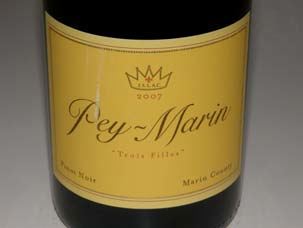 2007 Pey-Marin “Trois-Filles” Marin County Pinot Noir 14.0% alc., pH 3.51, 340 cases, $39. Low yields of nine clones. Sourced from two sites in west Marin County. Dijon clones and heritage selections. Aged 14 months in French oak. · Aromas of bright, fresh raspberry fruit initially, adding scents of brown spice over time. Tasty and juicy berry core with notes of vanilla and graham. Fuzzy tannins with a subtle grip of citrus peel on the moderately persistent finish. Still has some tannins to shed and should improve with another year or two in the cellar. Very good.
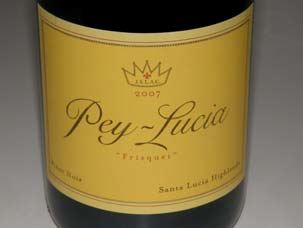 2007 Pey-Marin “Frisquet” Santa Lucia Highlands Pinot Noir 14.0% alc., 320 cases, $39. From a vineyard site adjacent Rosella’s Vineyard with chilly (frisquet) weather, foggy mornings and low yields. 35% new oak. Pommard and Wädenswil clones (50% of each). · Deep reddishpurple color in the glass. Restrained but pleasing scents of dark plums, sweet oak and spice. Delicious essence of intensely flavored and beautifully spiced sweet dark berries with a hint of root beer. The tannins are reigned in and there is a refreshing acid tang on the finish that makes you want to take another sip. Shows off the typical intense dark fruit of this appellation but has an appealing restraint and pleasing tameness.
Pey-Marin wines can be ordered through the online store on the informative and well-designed website (www.marinwines.com). Sign up for the mailing list to receive early notice of releases. Look for the Peys pouring at many of the Pinot Noir Festivals. The Pey-Marin “The Shell Mound” Riesling is easily one of the best California Rieslings I have ever drank. Try this wine with fresh Hog Island oysters and you will be on your knees. A tasting room is located in the historic Olema Inn at 10000 Sir Francis Drake Blvd. in Olema. Open daily from 12:00 to 4:00. A good bottle of Pey-Marin Pinot leaves me very content:
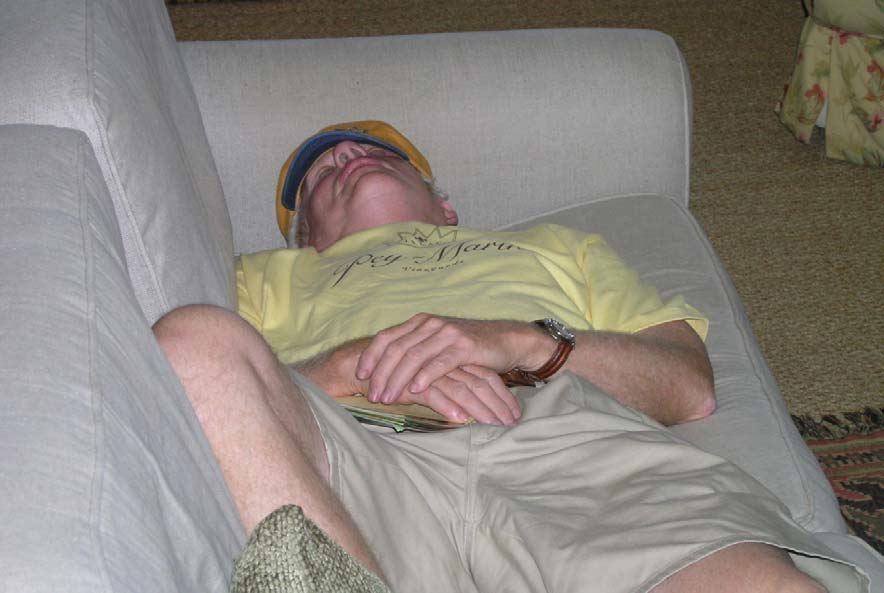
Three Carneros Pinot Noir Gems
Valerie’s VineyardThis 1-acre vineyard is a partnership between long time Sonoma County public relations person, Michael Coats, his wife Valerie, her parents and sister, and Chuck and Jerry Hanson who are owners of Hi-Time Cellars, one of California’s top wine retailers located in Costa Mesa (photo below shows the crew during the 2007 harvest). All the partners share in the work of the vineyard which is organically farmed and overseen by noted vineyardist Phil Cotourri. The vineyard, which was previously a plum orchard, was originally planted on resistant rootstock with a secret Russian River Valley clonal selection in 2000 by viticulturist Chuy Ordaz. It is located less than 500 feet from the appellation line between Sonoma Valley and Sonoma Carneros. Yields are kept at just under 2 tons per acre.
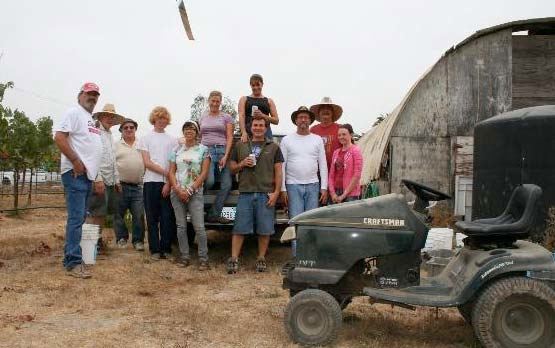 The estate Pinot Noir is crafted by B.R. Cohn Winery’s winemaker, Tom Montgomery, at B.R. Cohn Winery in Glen Ellen. Production is tiny and each vintage since the inaugural commercial bottling in 2004 quickly sells out. Check Hi-Time Wine Cellars (www.hi-timewine.net) for availability or e-mail michael@coatspr.com. Visit the website at www.valeriesvineyard.com for more information.
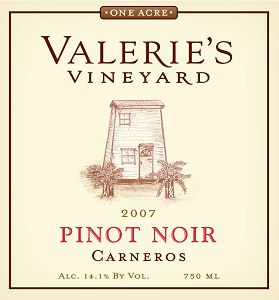 2007 Valerie’s Vineyard Carneros Pinot Noir 14.1% alc., 88 cases, $40. Aged in a mix of new and two-year-old French oak barrels for 17 months. · Nuanced nose offering pleasing aromas of dark berries, black plums, pine, dark caramel and soy sauce. Deep in color but moderately light in weight with plenty of dark fruit powered pleasure. Bright and focused with gossamer tannins offering alluring Pinot delicacy. A beautifully crafted wine that makes a statement and is well worth a search. A gem.
Trinitas CellarsTrinitas is the Latin word for Trinity symbolizing sun, soil and humanity, the three ingredients needed for the production of wine. It further reflects the triumvirate of the wine country lifestyle, Meritage Resort & Spa, and Trinitas wines. Tim and Steph Busch founded Trinitas Cellars in 2000, and opened their hotel, The Meritage Resort & Spa in Napa, in 2006. The winemaker is Kevin Mills, a graduate of Grayson County College Viticulture and Enology program in Denison, Texas. He spent over four years mentoring under Peju Province Winery winemaker Sean Foster. The Trinitas portfolio of wines includes multiple varietals including a single Pinot Noir sourced from Carneros. The site in Carneros is near the tidal wet lands and primarily (90%) from Sonoma Carneros. I reviewed the 2007 Trinitas Cellars Carneros Pinot Noir in September, 2009 and found it to be muscular and Syrah-like. The 2008 version is a horse (wine) of a different color.
 2008 Trinitas Cellars Carneros Pinot Noir 15.5% alc., pH 3.76, 880 cases, $28. Low yields, aged in 60% new French oak for 10 months. · Moderate reddish-purple color in the glass. Pleasing aromas of ripe black cherries, strawberries and raspberries accented by a wild flower bouquet and supporting toasty oak. A riper style with a middle weighted, earth-kissed cherry core offering a grilled meat, smoky and dusty edge with a hint of root beer. Admirable finesse makes for easy drinking. A little more alcohol than I prefer, but it is well-integrated. Plenty of pleasure for the tab. Very good (-).
Sean Minor WinesThe 2008 Sean Minor Carneros Pinot Noir is one of the rare California Pinot Noirs priced under $20 that really delivers both true Pinot Noir varietal character and a good drinking experience. An online retailer proclaimed recently that this wine sold out from the winery in 60 days after release, but the wine is still available on the website at www.4bearswinery.com. Sean Minor began making value-priced wines in 2005 under the Four Bears Winery name (honoring the owner’s four children). Minor, a wine industry veteran, found it difficult to find affordable, high-quality California wines for everyday drinking. With the assistance of his winemaker friend Will Bucklin, who worked with Minor at King Estate in Oregon, Minor embarked on a quest to fill this void. Minor eventually incorporated 4 Bears into the Sean Minor Wines label and now produces five varietals from Sonoma and Napa using purchased bulk wine, all priced under $20. Projected production is 25,000 cases.
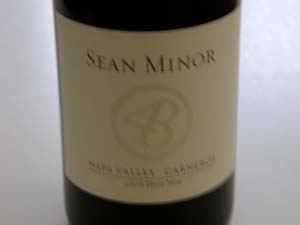 2008 Sean Minor 4 Bears Napa Carneros Pinot Noir 14.5% alc., $13. · A spicy mother on the nose and palate with added interest from scents and flavors of strawberries, woodshed and cardamon. Lightbodied but pleasing with enough tannin to support the splashy fruit. True to the varietal and surprisingly good for the price. Very good (-).
Dutton-Goldfield: Upper EchelonThis winery is a partnership between veteran winemaker Dan Goldfield and viticulturist Steve Dutton. Dan is an energetic, high-spirited and talkative winemaker who as a young man intended to enter medical school. At a wine tasting in 1983 with noted winemaker, Larry Brooks (Acacia, Campion), Dan had an epiphany and decided to become a winemaker himself. He received a master’s degree in enology from University of California at Davis and honed his skills at Robert Mondavi Vineyards, Schramsberg, La Crema and Hartford Court. Steve is the son of noted Russian River Valley farmer, Warren Dutton, and now heads up the Dutton Ranch with his brother Joe. It was Warren that suggested Steve and Dan form a partnership in 1998. The partnership was consummated at a Sebastopol pizza parlor with a handshake, and the winery has become a member of the top echelon of California producers of Pinot Noir. Dutton-Goldfield’s Chardonnay, Syrah and Zinfandel are also top notch. Small amounts of Pinot Blanc and Gewürztraminer are produced as well and are insider favorites. Pinot Noir grapes are sourced from several Dutton Ranch properties in the Russian River Valley and Green Valley viticultural areas with additional vineyard sources in the Sonoma Coast and Marin County appellations. The winery owns 80 acres, but 95% of the annual 7,000 case production comes from Steve Dutton’s Dutton Ranch vineyards. The Dutton-Goldfield tasting room has been shared with Balleto at 5700 Occidental Road in Santa Rosa, but a new facility is scheduled to open in March 2010 at the western corner of Gravenstein Highway and Occidental Road in Sebastopol. The 2007 lineup of Dutton-Goldfield Pinot Noirs is very impressive and highly recommended. For reviews of the winery’s Freestone Hill and Sanchietti Vineyard bottlings, refer to the feature on Green Valley in this issue. Winemaking is straightforward with de-stemmed grapes placed into small open top fermenters, cold-soaked for 5 days, and aged 17 months in 45% to 60% new French oak barrels.
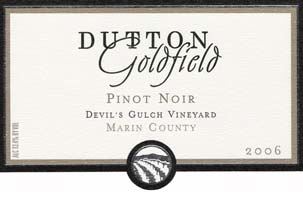 2006 Dutton-Goldfield Devil’s Gulch Vineyard Marin County Pinot Noir 13.6% alc., pH 3.65, 331 cases, $58. Sourced from Mark Pasternak’s vineyard that combines steep terraces, shallow soil, harsh climate, and well-chosen Dijon clones to produce small crops of unique fruit. · Very pleasant scents of wild berries, cardamon spice and oak. Nice mix of wild berry, plum, and toasty oak flavors that are juicy and vibrant sparked by a good vein of acidity. The middle attack is impressive, followed by a gentle dance on the palate, leading to a lingering, silky, fruity finish.
The heart and sole of Marin County viticulture lives in the jeans and cowboy hat of one man: Mark Pasternak. A majority of the vineyards in Marin County were either planted by Mark or are currently managed by him. Mark obtained his 65-acre property in 1971, at the tender age of 19, and several years later he became interested in wine. Spurred on by classes in viticulture he attended at Santa Rosa Junior College, and Michael Michaud, a winemaker acquaintance from Chalone, he planted 3 acres of Pinot Noir and 4 acres of Chardonnay on the terraces of his Devil's Gulch Ranch property. It was not a certainty that this site would ripen grapes for still wine, so Mark initially intended to sell the grapes for sparkling wine. Early on, Mark sold his grapes to Kalin Cellars and Schramsberg. By 1990, the grapes were deemed suitable for still Pinot Noir production, and Mark shopped the grapes to many high-end Pinot Noir producers. None showed any interest except Dan Goldfield, who was the winemaker at Hartford Court Winery. Dan was a believer in the potential of cool vineyard sites and by 1997, he was able to release a Hartford Court Marin County Pinot Noir composed entirely of Devil's Gulch Ranch grapes. These stellar wines put to rest any doubts about the potential of Marin County grapes to produce high quality Pinot Noir. Since that time, Mark has received inquires from the wineries that weren't interested in 1990, but his small production is now reserved only for Dutton-Goldfield and Sean Thackrey (see review below). The Devil's Gulch Ranch Pinot Noirs have developed quite a devoted cult following over time, rivaling the reputation of Marin's beloved Grateful Dead.
2007 Dutton-Goldfield Devil’s Gulch Vineyard Marin County Pinot Noir 13.5% alc., pH 3.63, 325 cases, $58. · Deeper colored than the 2006 vintage. Initially subdued, the nose explodes with time in the glass offering intense scents of wild berries and fresh cherries, spice and toasted bread. Hard to turn your nose away from this perfume. Delicious red and black fruit core with ripe soft tannins and a subtle citrus underpinning. Appealing finesse and impeccable balance. Fresher and richer than the excellent 2006 vintage. Still great two days later from a previously opened and re-corked bottle. Choose any superlative you want.
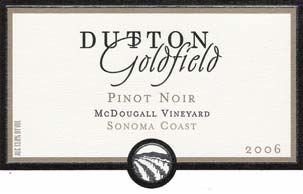 2007 Dutton-Goldfield McDougall Vineyard Sonoma Coast Pinot Noir 13.5% alc., pH 3.66, 198 cases, $58. From a wind-swept 9-acre vineyard on a ridge top at 1,100 feet near Hirsch and Martinelli vineyards on the true Sonoma Coast. Two Dijon clones. Farmed by Barbara and Rich McDougall. · A dark, savory, loamy wine that speaks of the earth. Aromas and flavors of intensely concentrated red and purple fruits, impressive for their freshness. Hints of pine pitch and brioche add interest. The ripe tannins have been reigned in, the wine is strikingly soft and smooth in the mouth and quite approachable now. I really like this wine for its seamlessness.
Dutton-Goldfield wines are largely sold through a mailing list and to wine club members at www.duttongoldfield.com. They are also available through the online store with discounts for case purchases. A very informative e-newsletter is published frequently.
The Devil’s Gulch Vineyard Pinot Noir bottlings from Sean Thackrey are more quirky, displaying a riper, unique style. I have reviewed several vintages previously and I include the 2007 vintage here.
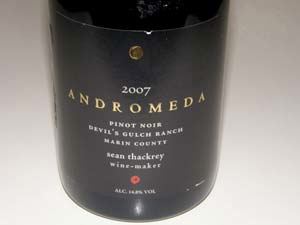 2007 Andromeda Devil’s Gulch Ranch Marin County Pinot Noir 14.8% alc., $45. · Unusual aromatics featuring floral, particularly roseate, musk and sage scents. The pedigree of the fruit shows through on the palate with the fruitiness offset with notes of spice and edible flowers. Smoothly textured with soft tannins and respectable finesse. Failed to noticeably improve after two days from a previously opened and re-corked bottle, so I am not sure cellaring will significantly alter the wine. Very good (-).
Cambria Julia’s VineyardThis wine has become a standard bearer for Central Coast Pinot Noir since it is produced in large enough quantity that it is widely available on the retail market. In addition, a number of Central Coast producers also craft Julia’s Vineyard designated Pinot Noirs as part of the Julia’s Vineyard Artisan Program. These wines have received considerable praise from the wine press. I am partial to the Julia’s Vineyard bottling from Lane Tanner, but the wines from Byron, The Hitching Post and Foxen are quite good. Most of the grapes from Julia’s Vineyard (90%) are devoted to Cambria’s bottling. At the end of 2009, Wine Enthusiast awarded the 2006 Cambria Julia’s Vineyard Pinot Noir the distinction of “#1 Wine of the Year.” According to Steve Heimoff, writing in the December 31, 2009 issue of the Wine Enthusiast, “This is the best Pinot Noir at this price on the market.” Hard to argue with this claim. Cambia Estate Vineyards and Winery is located along the Santa Maria Valley Wine Trail and covers 1,405 acres of benchlands 17 miles inland from the Pacific Ocean. Barbara Banke and spouse Jess Jackson established Cambria in 1986 after acquiring what was originally known as the Tepusquet Vineyard. Two prime vineyard plots were developed and named after Barbara’s two daughters: Katherine’s Vineyard planted to Chardonnay, and Julia’s Vineyard, devoted to Pinot Noir. All the Cambria wines are crafted by winemaker Denis Shurtleff and are grown, produced and bottled on the estate. Individual clonal Pinot Noirs are also offered including Clone 23, 2A, Pommard 4, and Dijon 115 and 667, all priced at $48. If you have the interest and the pocketbook, tasting these five Pinot Noirs side by side would be a wonderful education in clonal differences since the wines are vinified in the same manner. Cambria Julia’s Vineyard Pinot Noir is widely distributed, and often sold at a discount to its retail price of $25. I have seen the 2006 vintage which is still available for $16 and the 2007 vintage for $19). The wines are also available from the online store at www.cambriawine.com. The winery’s tasting room is open daily from 10:00 to 5:00 at 5475 Chardonnay Lane in Santa Maria.
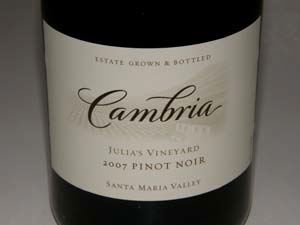 2007 Cambria Julia’s Vineyard Santa Maria Valley Pinot Noir 14.5% alc., $25. · More deeply colored than the 2006 vintage. Bright scents of cherries, strawberries, and oak toast and spice. A little riper and richer than the 2006 version with dark red cherry, berry and plum flavors augmented by a subtle loamy underpinning and a refreshing lift of acidity on the finish. Plenty of structure and intensity to satisfy and the soft tannins make for easy sipping. Very good (-).
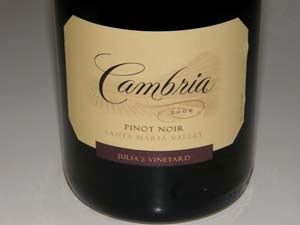 2006 Cambria Julia’s Vineyard Santa Maria Valley Pinot Noir 13.8% alc., $25. · Lovely Pinot perfume of cherries, strawberries, brown spice and cinnamon which loses some intensity in the glass over time. Tasty cherry and strawberry fruit offered in a moderately light style with supple tannins, bright acidity and a lingering red cherry and lemon toned finish. Highly drinkable and a perfect daily drinker. Very good (-).
Not So Fast!It is a common mistake and I have done it myself many times. I open a bottle of wine, eager to sample its charms, only to find disappointment with my first impressions. Pour it down the sink I proclaim, “Discard this swill” I shout, disgruntled and impatient with the absence of instant gratification. Patience is often proclaimed on the back label, but I am thirsty and want to ignore this recommendation, threatening to discard the beastly wine in loudly proclaimed defiance. I must admonish you to wait. I say, “Not so fast!” Wine has been ensconced in its oxygen free environment and needs to escape, to free itself and air out its charms. We need to swirl and sample, then swirl and sample some more. Patience is definitely a virtue when it comes to wine, especially Pinot Noir. When you open a bottle of Pinot Noir, leave the wine in the glass for a few minutes. Swirl it, sample it, but avoid making any proclamations. Give the wine at least 30 minutes or more in the glass. Consider pouring a big glass, even twice what you would normally pour so you can evaluate its progression over time. Cork the bottle, preserve it with Argon gas or pour it into a half bottle and check it out the next day and the next day. Quality balanced wines often improve over a day or two, adding more nuances, and offering more integration of oak and tannins. You will often be surprised. A wine that sings a day or two later will often age extremely well and give you some idea of how long to keep the remaining bottles. Remember, decanting can speed up the aeration process and you will never harm or detract from a young wine by decanting it. A recent experience will support my contentions. I recently received notification from a winery that I admire, Davis Family Vineyards, about the special release of a wine that has been three years in the making. During the winter of 2006, winemaker Guy Davis and his daughter Laura, his son Cole, and winery manager Annie Rambo tasted a few barrel samples. The group reminisced about how the winter between 2005 and 2006 had been noticeably rainy with flooding of the Russian River. Guy noted that the extensive rains had allowed him to dry farm his vineyard the entire season of 2006. Guy’s 2006 wines, including the Russian River Pinot Noir, Syrah and Zinfandel turned out great. The 2006 Davis Family Vineyards Pinot Noir turned up on practically every restaurant list in Sonoma County and San Francisco. On the day of the group tasting, Guy picked out three special barrels from his vineyard. Two barrels were from a section of the vineyard planted to Pommard clone and one barrel was from a plot planted to Dijon 777 clone at the top of the hill. The group agreed that these three barrels were extra special. Guy said these barrels reminded him more than any other wine he had ever made of the young wines he had tasted in the cellars of Burgundy when he was working there. Two years later, Guy brought the group together to taste again and he proudly offered a blend of those three special barrels that had been together for 6 months while the rest of the 2006 vintage Pinot Noir was bottled. The wine was so special that Guy decided to release the first official “reserve” wine from Davis Family Vineyards. 70 cases were produced from the estate vineyard, bearing the designation, “PinnaCole,” a name that is a play on pinnacle, meaning the peak, with a nod to Cole, Guy’s son, the cellar master and assistant winemaker. Guy proclaimed that this wine was a perfect marriage of Russian River and Burgundy Pinot Noir. This special wine was offered recently to insiders on the winery’s mailing list at $60, not inexpensive, but reasonable considering the extra care and cost involved in its production. Now, to get to the point. When I first opened this wine, I wandered what all the excitement was about. It was dull, closed, unexciting. I stuck a cork in the bottle and decided to sample it the next day. When I revisited the wine, a dramatic transformation had ensued. A dud was now a darling. This wine had become extraordinary! The lesson? You just can’t judge quality wines with a cursory sip. Availability is limited: contact annie@daviswines.com.
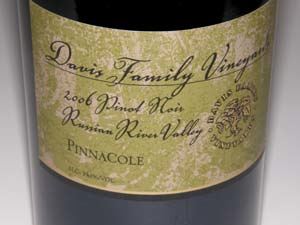 2006 Davis Family Vineyards PinnaCole Russian River Valley Pinot Noir 14.1% alc., 70 cases, $60. · Complex aromatic profile showing aromas of Bing cherries, dark chocolate, spice, wine cave and oak toast. Marvelous tasting core of chocolate-covered cherries with hints of cola, macaroon and earth robed in ripe tannins and bright acidity. Very smooth on the palate with a lasting cherry-filled finish. A dead ringer for a Nuits St. Georges 1er Cru Burgundy. Cellaring for a few years will produce a wine that Pinot geeks will fight over. If you must drink now, decant and bring on the short ribs.
Small Sips of Russian River Valley Pinot Noir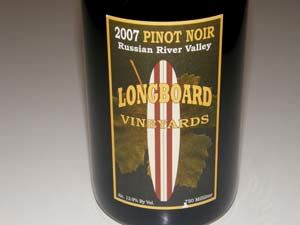 2007 Longboard Russian River Valley Pinot Noir 13.7% alc., 700 cases, $27. · Scents and flavors of ripe, roasted fruits with raisin overtones. Very smooth and soft in the mouth with silky tannins. Decent.
2007 Paradise Ridge Russian River Valley Pinot Noir 13.7% alc., 700 cases, $27. 2 vineyards, 5 clones. · Shy fruit overshadowed by scents of toasted oak and roasted nuts. Oak-tinged Bing cherry and strawberry tastes. Light and simple with generous oak. I preferred the 2006 version of this wine. Decent.
 2007 Fog Crest Vineyard Laguna West Russian River Valley Pinot Noir 14.5% alc., $32. Crafted by noted winemakers David Ramey and Daniel Moore. Sourced from a single neighboring vineyard. · Mineral-infused cherry and berry aromas with a little funk, forest floor, truffle and oak toast. Strawberry and cherry flavors with a little tutti-fruiti thrown in for interest. Lighter weighted with mild tannins and hi-tone acidity. A back porch Pinot with no pretensions. Decent (+).
2007 Ketcham Estate Russian River Valley Pinot Noir 14.4% alc.,pH 3.65, 760 cases, $32. Winemaker is Michael Browne. 80% Ketcham Vineyard, 20% O’Neel Vineyard, Nonella Vineyard and Manzana Vineyard. Pommard, Dijon 777, 667, 115 and 828 clones. Aged 16 months in French oak. · Aromas of cherry cola, lavender and wood chips. Moderately rich black cherry, black currant fruits with an earthy, spicy underpinning. Smooth in the mouth with a short, but pleasing finish. Decent (+).
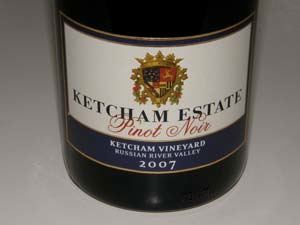 2007 Ketcham Estate Ketcham Vineyard Russian River Valley Pinot Noir 14.6% alc., 420 cases, $41. A reserve wine that is 100% Ketcham Estate Vineyard fruit. Sourced from a 16-acre vineyard with a broad selection of clones. · Restrained aromas of dark red cherries and berries with a complimentary hint of spice. Very tasty essence of dark cherries and plums with admirable persistence. Silky smooth with supple tannins. Still a little closed, but offers considerable upside potential. More sophistication and plushness than the regular bottling. Very good.
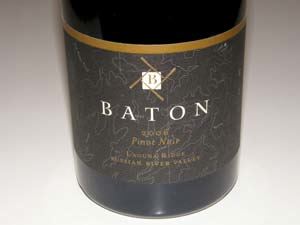 2006 Baton Laguna Ridge Russian River Valley Pinot Noir 14.9% alc., $35. Project of Bill Vyenielo, who as General Manager, helped develop Peter Michael Winery into the respected position it is today. Jeff Pisoni is the winemaker. · Moderately light in color. Delicate aromas of ripe black cherries and oak. Rich flavors of black cherries and dark berries with a hint of cola and oak. Smoothly textured with well-proportioned dry tannins and some interest and persistence on the fruit-driven finish. A solid, well-priced wine. Very good.
Small Sips of Sonoma Coast Pinot Noir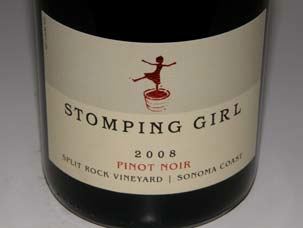 2008 Stomping Girl Split Rock Vineyard Sonoma Coast Pinot Noir 14.0% alc., $38. A newer family owned winery specializing in Pinot Noir from purchased grapes. · Shy aromatics with hints of black cherries, spice and warm cookies. Nicely weighted cherry and strawberry fruits carry over to a pleasant finish of moderate length. Doesn’t have the firm tannins often found in Sonoma Coast Pinot Noirs. I admire this wine for its balance and finesse. Very good (-).
2007 Hart’s Desire Rockin H Ranch Sonoma Coast Pinot Noir 13.9% alc., $20. Double Gold Medal at Sonoma County Harvest Fair. · Very strange aromatics featuring dilute dried cherry aromas, oak and green beans. Slightly confected cherry essence delicately structured with soft tannins. The flavors trump the nose. Decent.
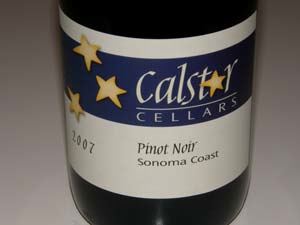 2007 Calstar Cellars Sonoma Coast Pinot Noir 14.2% alc., $22. From winemaker Rick Davis (Londer, Halleck). · The nose starts off bright with aromas of black cherries, red berries, spring herbs and a hint of oak. Over time in the glass, the intensity fades unveiling notes of wet leaves and brioche. Nicely herbed red fruits with discreet richness, soft tannins, and moderate persistence. A workhorse Pinot that is not extraordinary, but has everything in check leading to a pleasant drinking experience that is value-priced to boot. Decent (+)
2007 Roessler Wines Gap’s Crown Vineyard Sonoma Coast Pinot Noir 13.8% alc., 248 cases, $42. · The nose is very subdued at present showing little fruit and primarily herbal oak. Slightly tart raspberry, cranberry and blackberry flavors supported by sweet oak. Plush and reasonably intense on the mid palate with some persistence on the finish which leaves a sharp snap of acidity in its wake. Doesn’t impress at this price. Decent.
 2007 Ceritas Escarpa Vineyard Sonoma Coast Pinot Noir 13.7% alc., 130 cases, $54, wax seal. The name Ceritas is Spanish for “mineral expression of soil.” My first experience with this newer label from winemaker John Raytek and his spouse Phoebe Bass. · Deeply colored in the glass. Bright cherry cola, wild berry, and sawed wood aromas come at you. Hard to resist. Dark red fruits sing on the palate. Rich, but with admirable finesse and a good cut of acidity. This wine really aims to please with a pillowy texture, fine tannins, and a lingering finish. You get well-structured fruit, lively acidity, and low alcohol to boot: any whiners? Order online at www.ceritaswines.com or www.klwines.com.
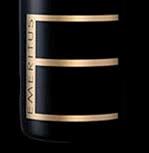 2006 Emeritus William Wesley Vineyard Sonoma Coast Pinot Noir 14.3% alc., $45. · Moderate reddish-purple color in the glass. A fruity nose displaying scents of dried cherries, grape jam and barnyard. Tasty wild berry and black cherry compote wrapped in firm tannins finishing with an aromatic and fruity finish of impressive length. With lively acidity and good harmony, this Pinot will age beautifully. A wine to partner with hearty food. Very good.
Small Sips of Central Coast Pinot Noir2008 Stomping Girl Lone Oak Vineyard Santa Lucia Highlands Pinot Noir 13.8% alc., $38. · Aromas of spiced plums and redwood are echoed in the flavors. Silky in texture with admirable finesse. Reasonably good but not much dimension beyond the fruit. Decent (+).
 2007 Brosseau B Vineyard Chalone Pinot Noir 14.3% alc., $35. · A big fruity nose sporting very ripe strawberries with hints of marzipan, raisins and maple syrup. Ripe, roasted and dried deep red fruits wrapped in moderately firm tannins and displaying a smooth and pleasing mouth feel. Decent.
2007 The Ojai Vineyard Bien Nacido Vineyard Santa Maria Valley Pinot Noir 14.0% alc., $37.40. · Really lovely dark garnet color in the glass. Very pleasing scents of spiced berries and cherries, with some brier patch, herb garden and subtle oak char. A middle weight offering purple fruits with hints of loamy earth, savory herbs and white pepper in the background. A bit linear but has plenty to recommend including a good spark of acidity on the moderately persistent finish. If you haven’t tried Ojai Vineyard wines lately, you should. A few years back, the Pinot Noirs were styled in a high alcohol, high extraction, Syrah-like fashion but winemaker Adam Tolmach has scaled everything back emphasizing the nuances of Pinot Noir that come with restraint and moderation. Very good.
2006 Hahn SLH Santa Lucia Highlands Pinot Noir 14.5% alc., $25. A mid-tier release aged in 50% new French oak. · On the nose, the toasty oak dominates the fruit and becomes even more oaky with time in the glass. On the palate, the attack features oak-toned cherry and berry fruit of medium weight. The tar and charcoal secondary flavors derived from oak detract from the pretty fruit core. Not anything like I remember when tasted at the 2009 World of Pinot Noir. Decent (-).
 2006 Pelerin Cuvee St. Vincent Santa Lucia Highlands Pinot Noir 14.1% alc., $36. Sourced from several top vineyards including Rosella’s, Paraiso, Fairview Road Ranch, and Tondre Grapefield. · Moderately dark reddish-purple robe. Fruity aromas backed by floral, wet oak and green notes. Oak-kissed dark red fruits are tasty but lack conviction. Supple tannins, bright acidity and overall a decent drink. Has a spark, but doesn’t reach excellence because of a detracting green note most evident on the finish. Decent.
2004 Whitcraft Winery Aubaine Vineyard San Luis Obispo County Pinot Noir 15.1% alc.. · Deep, dark purple color in the glass. Bright roasted dark stone fruits with oak char in the background. Dense, bold and muscular with a sweetness coming from the alcohol. Thick, grainy tannins with a chemical note appearing in the aftertaste. Very little to recommend here. Unsatisfactory.
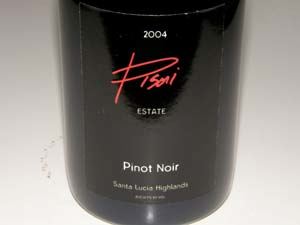 2004 Pisoni Estate Santa Lucia Highlands Pinot Noir 14.7% alc., $65. · Dark reddish-purple in the glass. Aromas of black cherries, dark berries and oak char. Full-bodied compote of red and black fruits with very impressive purity and harmony of fruit. The tannins have melded leading to a very smooth mouth feel, and the persistent finish has a refreshing spark of grapefruit peel. A fruit magnet that could last a few more years, but no reason to wait. Very typical of the Pisoni estate bottling which always beautifully reflects its terroir. Very good.
2003 Pisoni Estate Santa Lucia Highlands Pinot Noir 14.6% alc., $65. · Deeply colored. Aromas of dark berries, cigar box and anise veering to very ripe fruit scents. Generous core of ripe berry and plum fruit with a slightly grilled and raisiny taste. Highly structured with integrated soft tannins and decent length on the finish. A ripe, full-bodied wine with some appealing secondary characteristics. Liken this one to an aged Shaq at his best. Very good (-).
Small Sips of Oregon Pinot Noir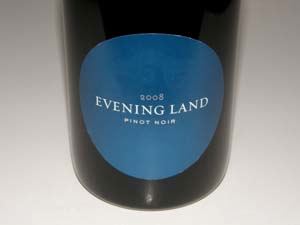 2008 Evening Land Vineyards Oregon Pinot Noir 13.4% alc., $25. Second vintage from a new Oregon and California producer. Sourced from Southern Oregon (50%), the Eola-Amity Hills (30%) and Dundee Hills (20%). Natural fermentation, 20% whole cluster. Noted Burgundy vigneron, Dominque Lafon, consults on the Oregon wines. · Dark reddish-purple in color. The shy dark red fruits are overshadowed by heavy oak toast and burnt caramel aromas. Juicy core of red and purple stone fruits and berries with a citrus underpinning. Full-bodied, fruit-driven and simple with supple tannins for easy daily drinking. Oregon fruit in a California style. Decent (+).
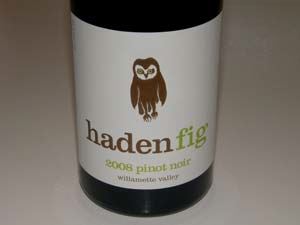 2008 Haden Fig Willamette Valley Pinot Noir 13.5% alc., pH 3.50, $25. Sourced from five Willamette Valley vineyards (Cancilla, Mahonia, Momtazi, Eola Springs and Madrona) cropped a 2.0 to 2.5 tons per acre. A debut wine from owner and winemaker Erin Nuccio. · Moderately deep reddish-purple color in the glass. Deep and heady scents of dark cherries, forest floor, oak toast and crushed rock. Light but pleasing in the mouth with tasty black cherry, cranberry and dark berry fruit with a faint sidecar of oak spice. Soft tannins and bright, refreshing acidity on the finish. A terrific value-priced wine from a great Oregon vintage offered in a classy and hip package. Relatively simple, but a very user-friendly drinker that will perform beautifully at the dinner table. Very good.
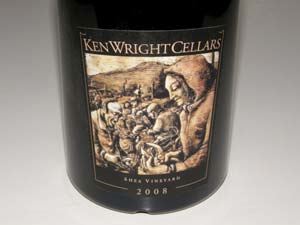 2008 Ken Wright Cellars Shea Vineyard Yamhill-Carlton District Willamette Valley Pinot Noir 14.1% alc., $42. · Subdued, but lovely aromas of red plums, wild berries and grilled meat. A bolt of dark red and black fruits attacks the palate with a vengeance, clothed in ripe tooth-sticking tannin and sporting a lively grip of acidity. Reserved and not together yet. Much better the next day from a previously opened and re-corked bottle with much improved integration of oak, tannin and acidity. Check back in 2 to 4 years. Very good.
2007 Soléna Grande Cuvée Willamette Valley Pinot Noir 14.5 alc., 3,500 cases, $25. Sourced from several sub-appellations of the Willamette Valley including the estate vineyard, Domaine Danielle Laurent. 100% destemmed, cold macerated, punched down by hand, 20 days skin contact, aged 6 months in 17% new French oak barrels, unfined and unfiltered. · Moderately dark reddish-purple color. Shy aromas of strawberries with accents of savory herbs and oak cask. A middle weight wine sporting dark red berry fruit that is silky and discreetly rich in the mouth with deft notes of oak. Softly textured with supple tannins for early drinking. Decent.
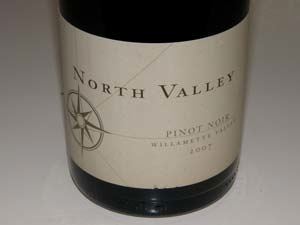 2007 North Valley Willamette Valley Pinot Noir 13.6% alc., $30. Crafted at Soter Vineyards using vineyard sources with diverse clones, soil types and microclimates. · Attractive scents of strawberries, black cherries and spice with a hint of smoke and volatile acidity. A lighter-weighted offering with an appealing essence of fresh berries accented by savory herbs, mocha, and citrus peel. A good daily drinker but hard to recommend at this price. Decent (+).
2007 Soléna Domaine Danielle Laurent Vineyard Yamhill-Carlton District Pinot Noir 13.7% alc., 350 cases, $45. Seventh vintage from this biodynamically-farmed 80-acre vineyard that is densely planted and located adjacent Shea Vineyard. Clones are Pommard and Dijon 115, 667, 777 and 828. High percentage of stems removed, 6-day cold soak, 25 days of skin contact, fermented in small lots in rotary barrels (barrels are rotated for “punch down” effect to gently extract color and tannins), aged 11 months in 33% new French oak barrels from a variety of coopers, unfined and unfiltered. · The nose is more savory than fruity with hints of oak toast, wet leaves and barnyard. The flavors trend to fresh wild berries matched with plenty of toasty oak that surfaces notably on the finish. Silky textured with complimentary fine tannins. The lovely fruit just can’t surface above the noise from the oak. Cellaring may allow more oak integration. For now, it is just decent.
2006 Winter’s Hill Vineyard Dundee Hills Pinot Noir 14.1% alc., pH 3.47, 1,195 cases, $29. From the winery’s 35-acre estate vineyard which is Certified Sustainable and SalmonSafe. De-stemmed, cold soaked for 2 days, aged 18 months in 25% new French oak. Winemaker Delphine Gladhart. · Aromas of ripe black cherries, berry jam and raisins. Juicy and moderately rich fruit pushing ripeness to the edge. Typical of the 2006 vintage in Oregon and will appeal to ripe fruit lovers. Decent.
2006 Soléna Willakia Vineyard Eola-Amity Hills Pinot Noir 14.5% alc., pH 3.63, 97 cases, $35. Pommard and Dijon clones. 100% de-stemmed, cold maceration for 8 days, fermented in rotary barrels, aged 15 months in 50% new French oak, unfined and unfiltered. · Very shy aromatics with little to report other than faint purple fruits and a hint of smoke. Delicious dark stone fruit core that is rich and satisfying wrapped in husky tannins. Very smooth and sensual in the mouth with a perfect rift of acidity. Solid, but not exceptional, and lacks aromatic interest. Very good (-).
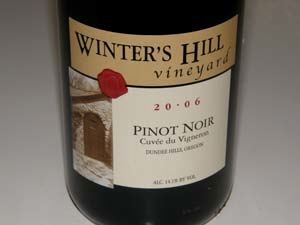 2006 Winter’s Hill Vineyard Cuvée du Vigneron Dundee Hills Pinot Noir 14.1% alc., pH 3.47, 226 cases, $39. Of the 21 acres planted to Pinot Noir in the estate vineyard between 1990 and 2000, only the Pommard clone is used in this bottling. Barrel aging is tailored to the tannin and fruit make-up of each lot of fermenting wine. Aged 18 months in barrel. · Subdued but pleasing aromas of black cherries, earthy loam and forest floor. Fairly thick and imposing core of darker cherry and berry fruit with hints of mocha and marzipan. Similar to the regular Dundee Hills bottling but more high brow with better harmony and less overripe tendencies. Very smoothly textured with a fresh and lively finish. Very good.
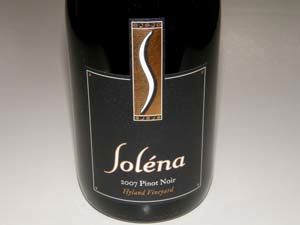 2006 Soléna Hyland Vineyard McMinnville Willamette Valley Pinot Noir 13.5% alc., pH 3.33, $45. This 120-acre vineyard planted in 1970 and purchased by the Montalieus in 2007. Soils are volcanic Jory and some Nekia. The vineyard contains both own-rooted old-growth plantings and newer, grafted Pinot Noir clones. Grapes were de-stemmed, 6-day cold soak, fermented in rotary barrels, aged 15 months in 215 new French oak, unfined and unfiltered. · Very subdued aromatics with delicate floral and berry scents. Impressive infusion of berry jam on the palate with oak in the background. Smooth and harmonious with supple tannins, snappy acidity and moderate persistence on the finish. A sophisticated wine of great interest. Very good.
2006 Winter’s Hill Vineyard Reserve Dundee Hills Pinot Noir 13.5% alc., pH 3.56, 146 cases, $45. The best six barrels of estate fruit out of 40. Aged 17 months in 50% new French oak barrels. · Dark purple in color in the glass. Nicely composed nose that is both fruity and floral as well as spicy. A berry jubilee on the palate with a hint of savory herbs and Provencal spices. Full-bodied, with noticeable lithe tannins and a moderately long fruit presence on the snappy finish. Tasted later in the day from a previously opened and re-corked bottle, the wine had lost most of its charm. I am not sure this one can stay the course. Decent (+).
Pinot Briefs
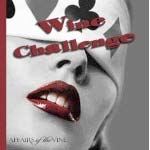 Challenge Me at Pinot Summit I was one of the judges for the 8th Annual Pinot Noir Summit. Pit your palate against mine and let me know what you think. On February 27, 2010, the Pinot Noir Summit returns to the Bay Area. You be the judge. Blind taste and review 40 top-rated Pinot Noirs from around the globe and compare your results with the judging panel which considered the final 40 wines as the best out of more than 250 entered. Enjoy Pinot Noir workshops, meet and taste top Pinot Noir winegrowers, winery owners and winemakers. Find out at the Shootout Ceremony which wines finished at the top. Only 250 tickets available. 12:00 PM to 8:30 PM, Osher Marin Jewish Community Center, 200 N. San Pedro Road, San Rafael, CA 94903. Attend the entire Summit for $100 including blind judging, workshops and reception (visit http://affairsofthevine.com/store/item.asp?itemid=122 for the judges discount offer), or the evening reception and awards ceremony for $60 (visit http://affairsofthevine.com/store/item.asp?itemid=123 for the judges discount offer).
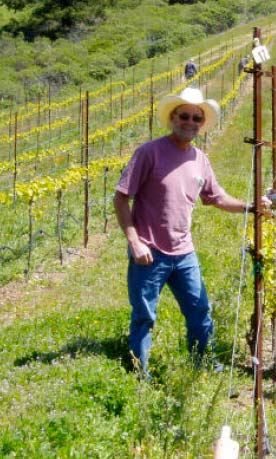 Haiti Fundraiser Mark Pasternak, winegrower, rancher, artisan food supplier to restaurants, and owner of Devil’s Gulch Ranch in Marin County, was in Haiti with his family when the recent earthquake struck. They stayed to help out for a couple of weeks. Mark is actively raising funds to assist the unfortunate in Haiti. A special dinner was already held at Cavallo Point that raised over $15,000, with Schramsberg, Kendric Vineyards, Stubbs Vineyards and Dutton-Goldfield donating the wines. More dinner fundraisers are planned including an event at Flour and Water in San Francisco February 21 (http://flourandwater.com/haiti-benefit-dinner/). Other tentative dates are March 15 or 16 at La Folie in San Francisco and March 7 at Perbacco in San Francisco. Mark plans to auction a dinner for 12 at Devil’s Gulch Ranch cooked by the chef from each restaurant that will include older vintages of rare Marin County wines pulled out of the collective cellars of Mark and his winemaker friends. Every penny raised goes 100% directly to Haiti with no administrative fees. The Devil’s Gulch website (www.devilsgulchranch.com) has further information and photos and videos taken by Mark’s family in Haiti. Mark is a true humanitarian and I urge you to support his fund raising efforts.
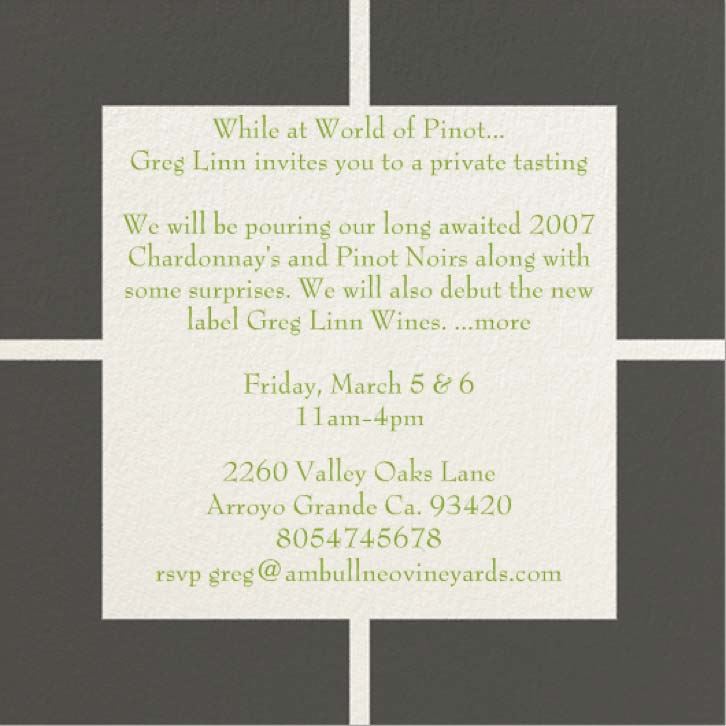 Greg Linn of Ambullneo Announces Private Tasting and Debut of Greg Linn Wines Directions from the South: 101 North exit Los Berros/Thompson Rd and turn left. Go 3.0 to 3.5 miles to El Campo Rd and turn left. Go 1.5 miles to stop sign at Halcyon Rd and turn left. Make first left on Aloma Way, then first left again to arrive at 2260 Valley Oaks Lane. Directions from the North: 101 south exit at El Camp Rd - it’s an unconventional exit that turns off 101 like a normal street with no ramp. As a reference, look for Grand Ave, then start looking for El Campo. Turn right only, and in about 1 mile arrive at a stop sign at Los Berros and turn left, then first right back on to El Campo, then follow directions as above. No charge. Greg’s website is www.ambullneovineyards.com.
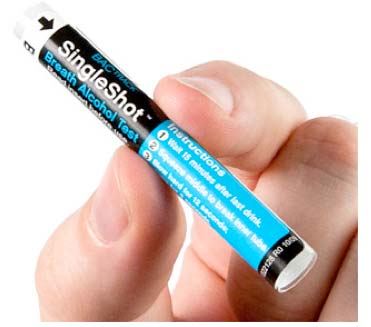 BACtrack® Intoduces BACtrack SingleShot™ A single-use disposable breath alcohol tester that is over 99% accurate. Easily fits into a pocket or purse and provides rapid results. A 10-pack is $34.99. This is a small price to pay for peace of mind when concerned about a very expensive DUI. By the way, you can’t trick a breathalyzer test by eating strong foods like onions, coffee grounds or breath mints. Mouth wash can slightly mask the smell of alcohol on your breath, but it won’t lower a breathalyzer reading. Also, mouthwash contains a small amount of alcohol and could potentially increase the reading. Placing pennies or a battery in your mouth is ineffective as well. The only way to decrease a BAC reading is to play it safe and don’t drink and drive. For more information and to order visit www.breathalyzer.com. Around the World in 80 Sips™ Bottlenotes (www.bottlenotes.com) is hosting a special wine tasting at Crushpad, San Francisco’s unique “urban winery” on Thursday, February 25, from 6:00 to 8:00 PM. Tickets are $60 in advance. Wineries include PAX Wine Cellars, Picket Fence Vineyards, Rodney Strong, Scholium Project, Stryker Sonoma, Waipara Springs and more. Grand Coeur/Big Heart Decanter In time for Valentine’s Day but useful any time is this heart shaped decanter from Etienne Meneau sculptures, makers of limited-edition wine decanters. Only 8 numbered
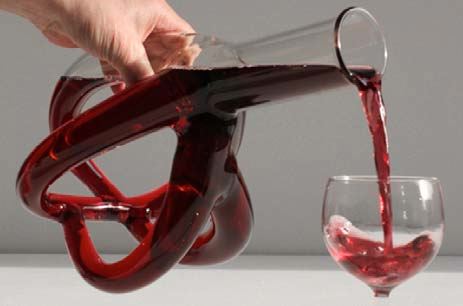 decanters produced (2,500 euros plus shipping). Visit http://grandcoeurbigheart.blogspot.com. Find other unique decanter designs at www.riedel.com (“Eve” decanter), www.clowines.com (“Morte” decanter produced in Oregon with a skull in bottom), and www.unicahome.com (“Sfera” decanter by Italian company Ichendorf). Winesandtimes.com Plan your winery tour, find winery events, winery hours with interactive Google maps to get directions to over 3,200 vineyards and wineries. Do It Yourself Tasting Notes Generator Wine retailers are quoting anyone who has a positive opinion of a wine. Forget that it takes plenty of skill backed by knowledge to write useful tasting notes. Any wine blogger can become a self-professed expert by using various programs such as the Silly Tasting Notes Generator at www.gmon.com. Winehotelscollection.com A worldwide directory of unique wine hotels and resorts including golf courses surrounded by vineyards. The focus is on destinations in South America and Europe. California has 2nd-largest Grape Crop Ever in 2009 The harvest was bigger than anticipated in California leading to the second-largest crop in California history. Wineries crushed 3.7 million tons of grapes in 2009 according to the annual report by the California Department of Food and Agriculture and the United States Department of Agriculture, close to the record 2005 harvest. Chardonnay and Pinot Gris had the largest percentage crop increase compared with 2008. The expectation is that the generous harvest will lead to more wine availability and lower prices for all types of California wine. This is not good news for premium and ultra-premium Pinot Noir producers who are already struggling with sales. Current Winery and Label Numbers According to Wine Business Monthly (February 2010), there are 6,014 wine brands in the United States, an increase of 498 brands during 2009. E.&J. Gallo Winery, the largest producer in the United States with an estimated sales volume of 78 million cases, markets 60 brands. There are now 6,223 wineries in the United States with California leading the pack with 3,047 (bonded and virtual), Washington second with 564, and Oregon third with 453. Variety or Varietal? The words variety and varietal are often misused and interchanged with impunity. Each word, however, has a clear meaning. A grape variety is a noun, such as Pinot Noir. A grape varietal is an adjective that would be used, for example, to say a wine is varietally correct. Confusingly, varietal is also proper when referring to a wine made from a single variety. When talking about plantings in a vineyard, the word variety should be used, as in, “Pinot Noir is the variety most planted in that vineyard.” When discussing the different wines produced by a winery, they should be referred to as different varietals, as in, “That winery produces an impressive lineup of varietal wines.” Bogus Pinot Noir If you drank some Red Bicyclette brand of Pinot Noir and didn’t think it was varietally correct, you were right. Executives from two wineries and five cooperatives in the Languedoc, as well as the negociant Ducasse and conglomerate Sieur d’Arques, have been charged by the French government of selling millions of euros worth of fake vin de Pays d’Oc Pinot Noir to E.&J Gallo Winery for its Red Bicyclette brand. The accused have admitted doctoring the Pinot Noir with significant amounts of cheaper Merlot and Syrah. Read more at www.decanter.com/news/294567.html. I have always felt this was common practice in Pinot Noirs from the Languedoc based on the flavor profiles of a number of these wines.
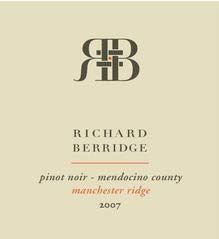 Berridge Wine Company Inaugural Releases Richard Berridge ultra-premium 2007 Pinot Noirs have been released along with a launch of the winery’s new website (www.berridgewines.com). 9 cases of the van der Kamp Sonoma Mountain Pinot Noir ($100) and 24 cases of the Manchester Ridge Pinot Noir ($100) remain. These wines were first poured to the public at last year’s World of Pinot Noir and generated some buzz. The wines are crafted by noted vineyardist and winemaker Virginia Lambrix. Owner Richard Berridge also produces Pinot Noir in Central Otago under the Drystone label.
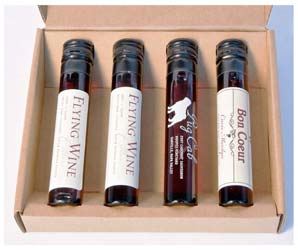 WineSide’s Trial-sized Tubes San-Francisco-based Brixr recently launched a set of tasting packs specifically for sampling. Brixr offers a Pinot Noir Tasting Pack including samples of three wines from the Santa Lucia Highlands and one from the Sonoma Coast. Along with the four samples, recipients of the pack get a coupon for two full-sized bottles of their favorite sampled wines, shipped directly to their door at no charge. The idea is to try before you buy. The idea was hatched at Crushpad for their own customers with many other wineries expressing interest. Visit www.brixr.com. Sales of Privately Owned Wineries Continue In early 2009, Kosta Browne sold a controlling interest to investment firm Vincraft, and later in 2009, Napa-based Cliff Lede purchased Breggo Cellars in Anderson Valley. Copain co-founders Kevin McQuown and Wells Guthrie have added a new investment partner at their winery and separate custom-crush facility in Santa Rosa, California. Guthrie has sold his interest in the crush company but will stay on at Copain as winemaker. More than 30 producers, including Eric Kent and Donum, use the Copain Custom Crush facility. Guthrie hopes to recapitalize the winery through the sale and purchase new vineyards. Copain currently owns a 20-acre vineyard in Anderson Valley, but buys the majority of its grapes from regions throughout the state. Pinot Noir Shows Up in Central Oregon Doug Maragas is somewhat of a maverick winegrower who established Maragas Winery in 1999 in the high desert of Central Oregon between Madras and Richmond. According to Wines & Vines (January 12, 2010), Maragas began planting grapes on a 40-acre property in 2006. He has planted a few acres to many different varieties and clones including Pinot Noir. None of these varieties have been tested in this area before. Stay tuned.
Dry River: Martinborough’s Cult Pinot Noir
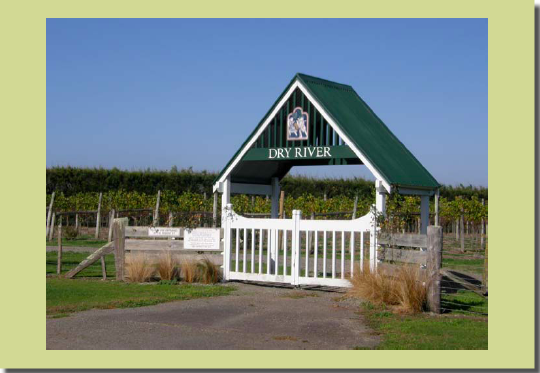 There is nothing else quite like Dry River Pinot Noir in New Zealand, or even in the World for that matter. Dry River is located in Martinborough, North Island of New Zealand, and was the name of one of the oldest Wairapa sheep stations in New Zealand, dating to 1877. It was later named Dyerville, and it was here in 1979 that Neil and Dawn McCallum planted a vineyard. The area subsequently become known as the Martinborough Terrace, now famous for Pinot Noir. McCallum is an opinionated winemaker, a committed “terroirist,” who is highly respected by his peers. His wines have achieved cult status in New Zealand, although he never submits the wines for judging. There is no tasting room and the wines are quickly sold to an eager mailing list of customers with a few bottles exported to the United States, Asia and the United Kingdom. The wines are known for their longevity. A tasting McCallum staged with Bob Campbell MW in 2004 and reported in The World of Fine Wine (Issue 19, 2008), revealed that older vintages of Pinot Noir dating back to 1989 were still youthful. Campbell enthusiastically described the wines as showing “high levels of flavor intensity and ripeness, and impressive longevity.” McCallum uses little oak (20%), and the Pinot Noirs have high levels of grape tannins, requiring 3 to 4 years to begin to open up. In 2002, the winery and 30 acres of vineyards were sold for $7 million with the new owners infusing cash for expansion and updated equipment. McCallum has remained on as the chief winemaker. McCallum writes extensively and his musings are posted on the Dry River website under the “Jottings” heading (www.dryriver.co.nz). You will find these essays scholarly, informative and insightful.
2006 Dry River Martinborough New Zealand Pinot Noir 13.5% alc., $80. Imported by RO Imports, LLC, Napa, CA. · Syrah-like color and structure. Very contemplative nose showing nuanced scents of a variety of wild dark berries, with considerable oak-derived notes of spice, browned marshmallow, brandy, and vanilla. Utterly amazing intense and saturating sun-kissed flavors of plums, blackberries, and currants with a savory, woodsy undertone and a hint of tangerine peel on the extremely long finish. Easy to mistake for a young Grand Cru Burgundy with the biggest tip off being the amazing persistence at the end. Beautifully balanced for the long haul. Still exceptional the next day from a previously opened and re-corked bottle displaying more softness and harmony. A truly unique wine of great distinction that stands out from the crowd. Serve this wine blind to any of your Pinot geek buddies, let them try to guess where it is from, and you will find many surprised winos.
|